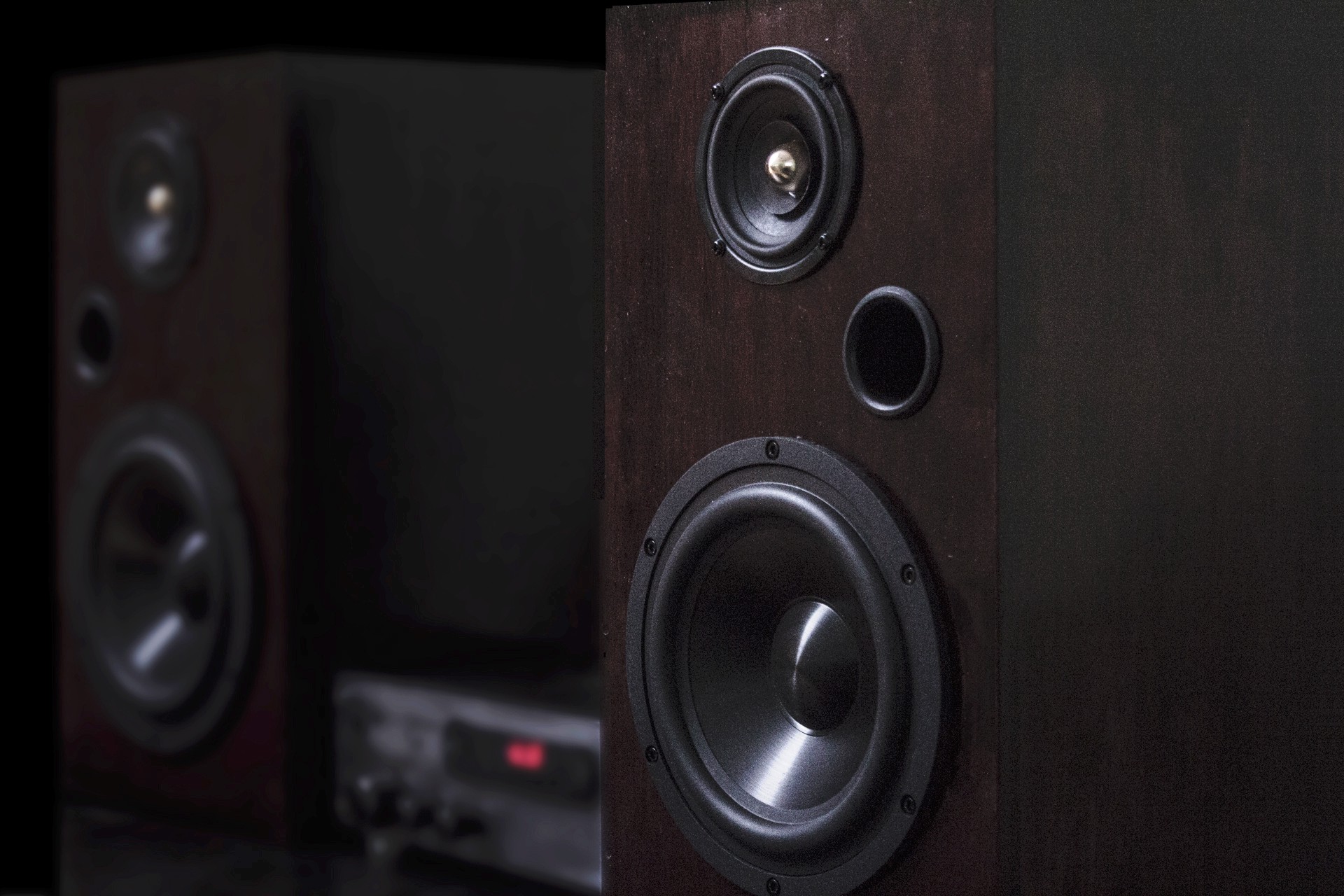A DIY story of my bookshelf speakers + Hi-Fi music system
Many years ago, in the late 90’s, when I was a child, there was a specific music system by a popular audio manufacturer named “Aiwa”. A really good music system (for its time) that we had for several years. Back then, Aiwa was the Apple of audio in all over Asia. They made the most popular Hi-Fi systems of their time in most Asian markets and crushed it in sales. Even Sony was afraid of them and were constantly losing out to Aiwa (This was in the early 80’s).
It all started one day — when I came back from my school and couldn’t find my much loved music system anymore. It was when I learned the company was acquired and shut down by Sony and we had to sell it quick to avoid heavy losses (they weren’t as cheap back then).
Ever since that day, I was in constant pursuit — the feeling of joy from listening to music through those near-perfect speakers. But, it wasn’t just about sound quality, it was about a specific sound signature and the memories associated with it. The particular sound signature reminded me of my happiest childhood memories.
So, since then, I had tried hard to recreate the sound that I only had a shadow of, in my mind — The sound of Aiwa.
Time passed by, school years came and went and so did my university years. Somehow, during this period, I developed a strong interest towards Physics and turned into an Electronics Engineer — even thought I majored in Biology. Abandoned music systems and amplifiers were my most favorite friends. I preferred soldering in the weekends instead of hanging out with real people or attending parties. Along the way, audio became my passion.
A decade later, here I was in Singapore. I suddenly seemed to miss my favorite piece of music. I thought it would be a good idea to buy some cheap speakers to simply get the job done. And so, I started out with a cheap $99 Creative speaker set. Somehow, there was something missing from the sound the system produced — there was no soul to it. I don’t mean that like an elitist, nor do I claim that like an arrogant self proclaimed audiophile. I genuinely felt that Creative didn’t have a soul. For example, if you buy a Sony Hi-Fi system, you know for sure it has a certain sound signature — it is always tuned to a V-shaped EQ. That’s Sony’s sound Signature. If you bought a Bose system, you know for sure that it’s going to have slightly boomy bass with reduced treble. That’s their signature. But what about Creative? Creative has no specific sound signature and frankly, they’re not really a proper audio company. They’re a technology company. And so, the sound from the Creative was way too sharp, the treble — almost ringing into my ears.
So, disappointed, I decided to break open and study the system as to why there wasn’t performing as well and if I could do something about it.
This investigation lead to my first project that was based off a broken Creative 5.1 speaker system. A small boombox with Arduino (to control the amplifier digitally):
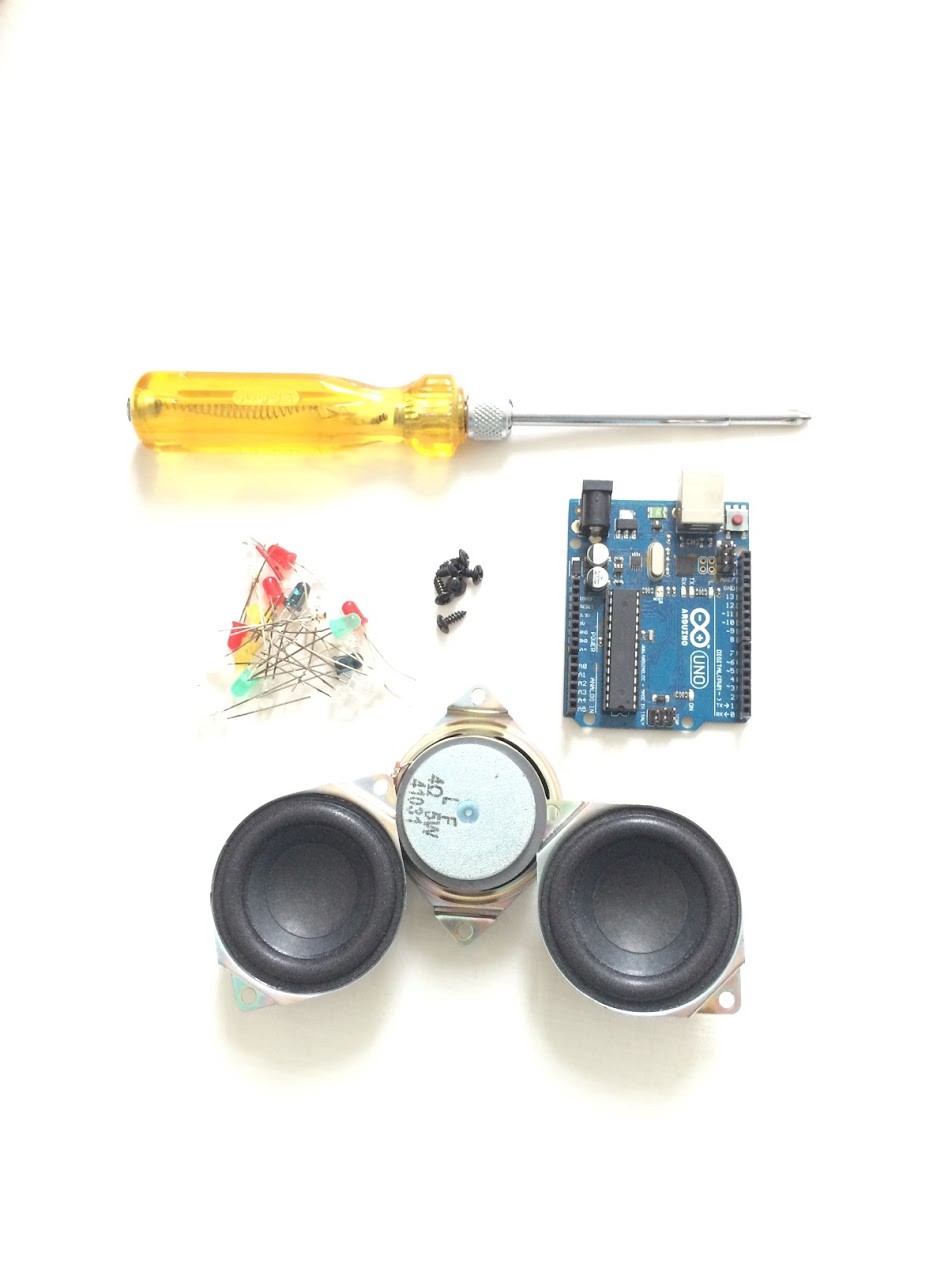
As for the Subwoofer, I tried to design many enclosures, including a recycled old wafer-biscuit tin.
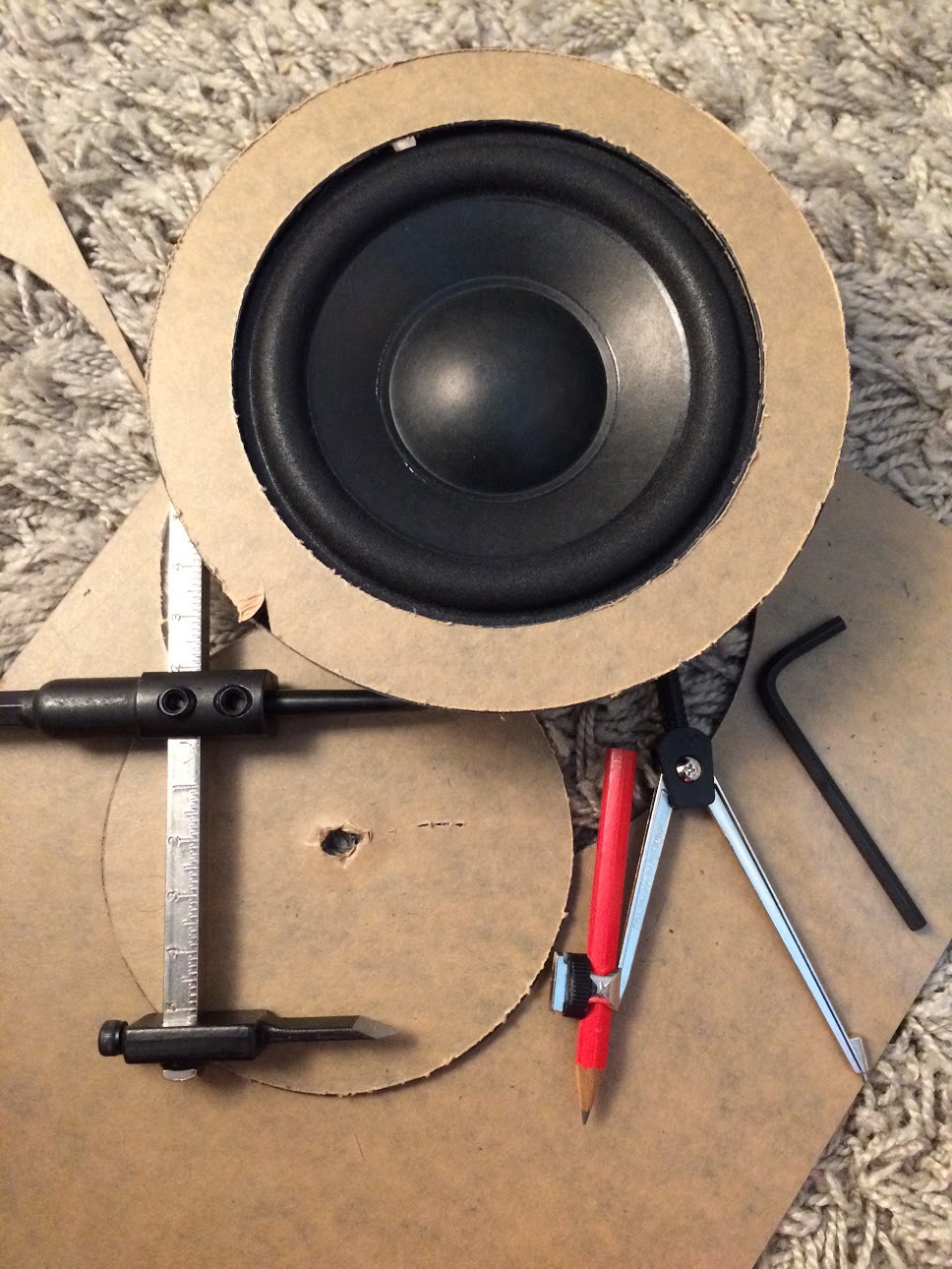
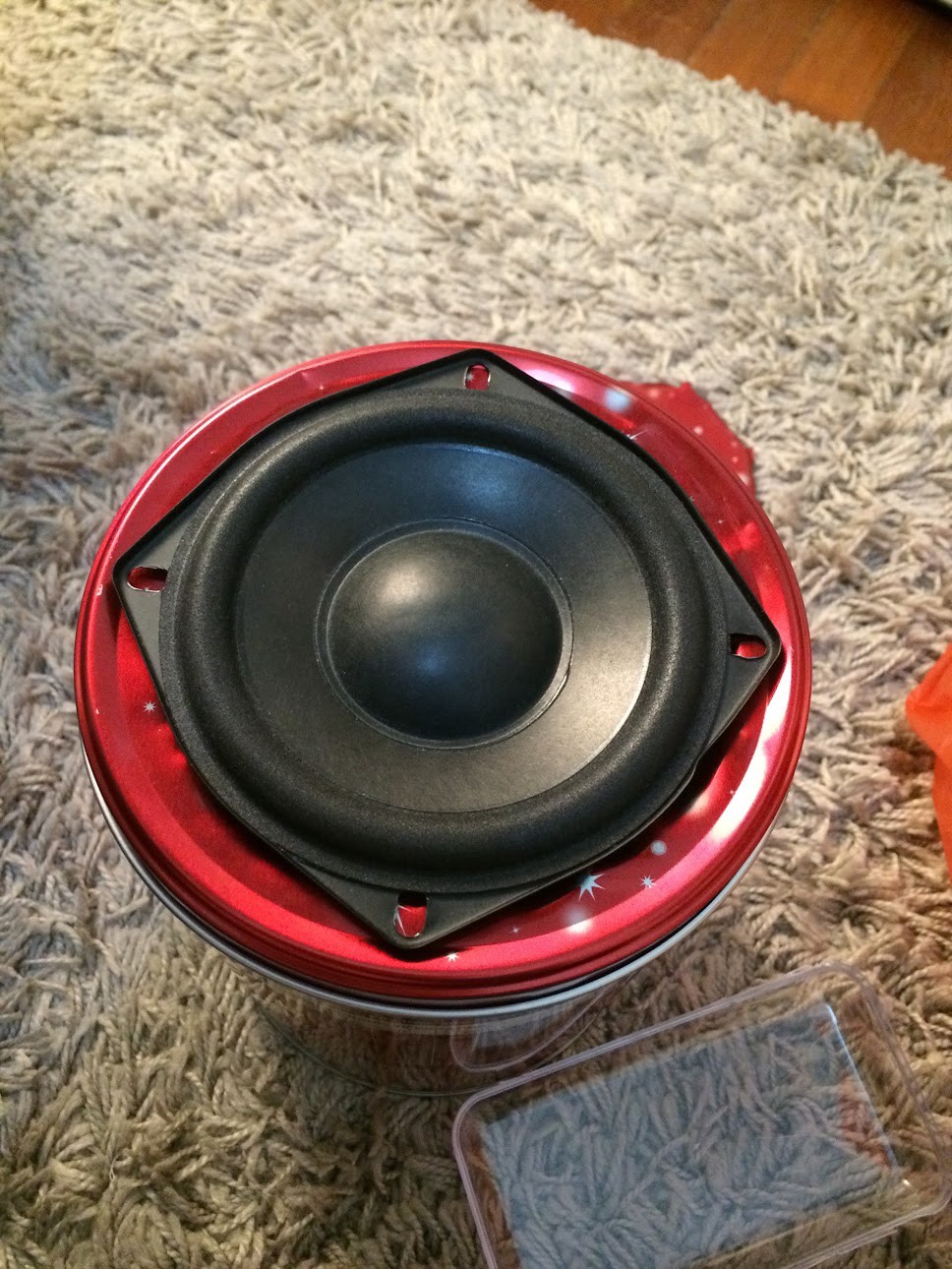
But, there was a problem — I found the quality of components used in the Creative system were basically garbage. Instead of using industry standard audio ICs from Texas Instruments or ST Microelectronics like most of their peers do, they opted for low quality ICs from non-reputed vendors from China. To be clear, China makes plenty of reputed ICs, just that they chose to use the non-reputed ones. I immediately threw the amplifier board away. But, that isn’t even the worst part, even after re-designing several enclosures, the speakers sounded horrible. For example, the sub-woofer would distort heavily even before reaching it’s mechanical limit (X-max). Yes, the speakers were that bad. I ended up throwing away those speakers. Good riddance! And so, here I was in Singapore, but I still missed my favorite piece of music, only, now I was $99 poorer, but, only wiser. However, breaking open into stuff gives one tremendous insight that you otherwise would never gain if you blindly trusted them by brand value.
I will never recommend any Creative speaker system or any of their products to anyone I know. Period.
Hello, Ritchie
A few weeks later, I flew back home for a long break. After many, many years, I thought it would be a good idea to pay a visit to my old haven, a.k.a Ritchie street — the electronics hub of Chennai.
Suddenly, I realized it would be a good idea to start my hunt for good speakers in Ritchie Street . And yes, there are specific shops that sell quality speakers for a good price.

There are many shops that sell all kinds of woofers, even branded ones! So, I scouted the entire place in search of good quality speakers.
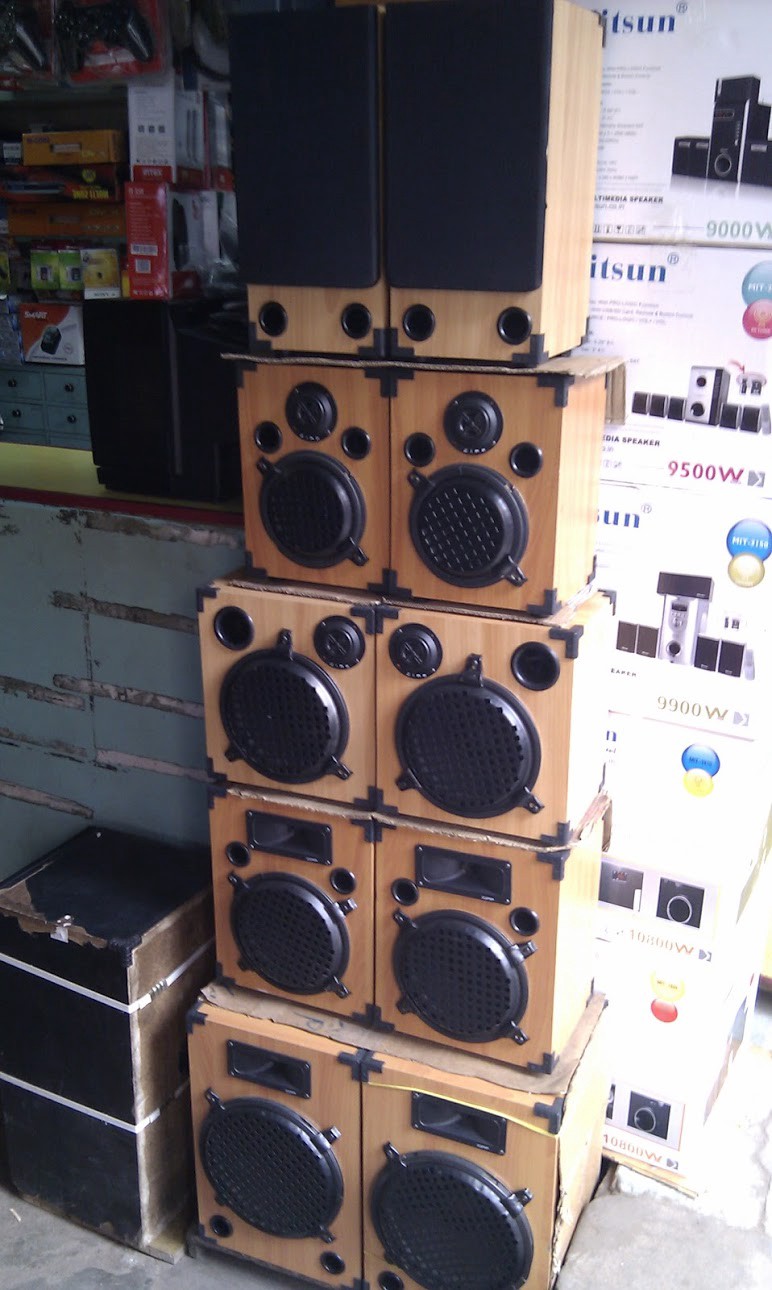
After about half a day, without much success. Speakers I found were either of bad quality or were not packaged properly, or were cheap models from China or Korea (both countries make top of the line speakers, but they weren’t sold here) leading to damaged diaphragms or dust caps.
They did sell some nice boxes, though, but, I was determined to make my own as I don’t trust their math. (I’m very particular about using the right box dimensions)
Eventually, I decided to use a pair of car speakers for my project, since it is the fastest way to buy speakers for your project. And Ritchie has a lot of places that sell branded car speakers.
And so, my hunt began. Ritchie is so big that it took me a whole week with 3 visits to scout there entire place in and out for a good deal. And finally I found the perfect speaker pair. It was a JBL GT7–5. 5.25" woofers with tweeters. I also grabbed a TDA7265 based amplifier for this project.
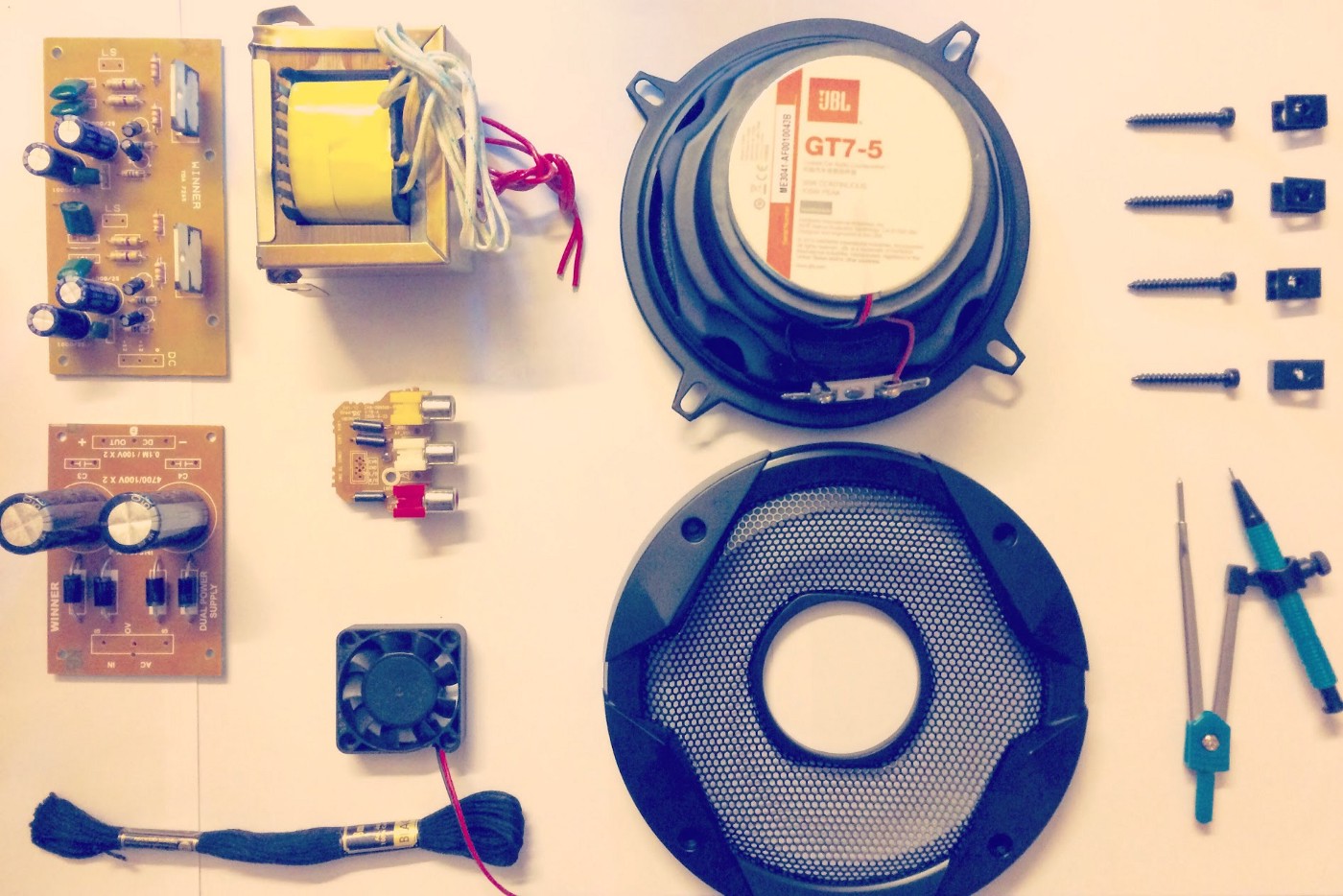
A trip to the kitchen stealing a pair of mom’s cooking containers and the speaker box was ready. I wanted a transparent enclosure and this seemed like the perfect option, after all.
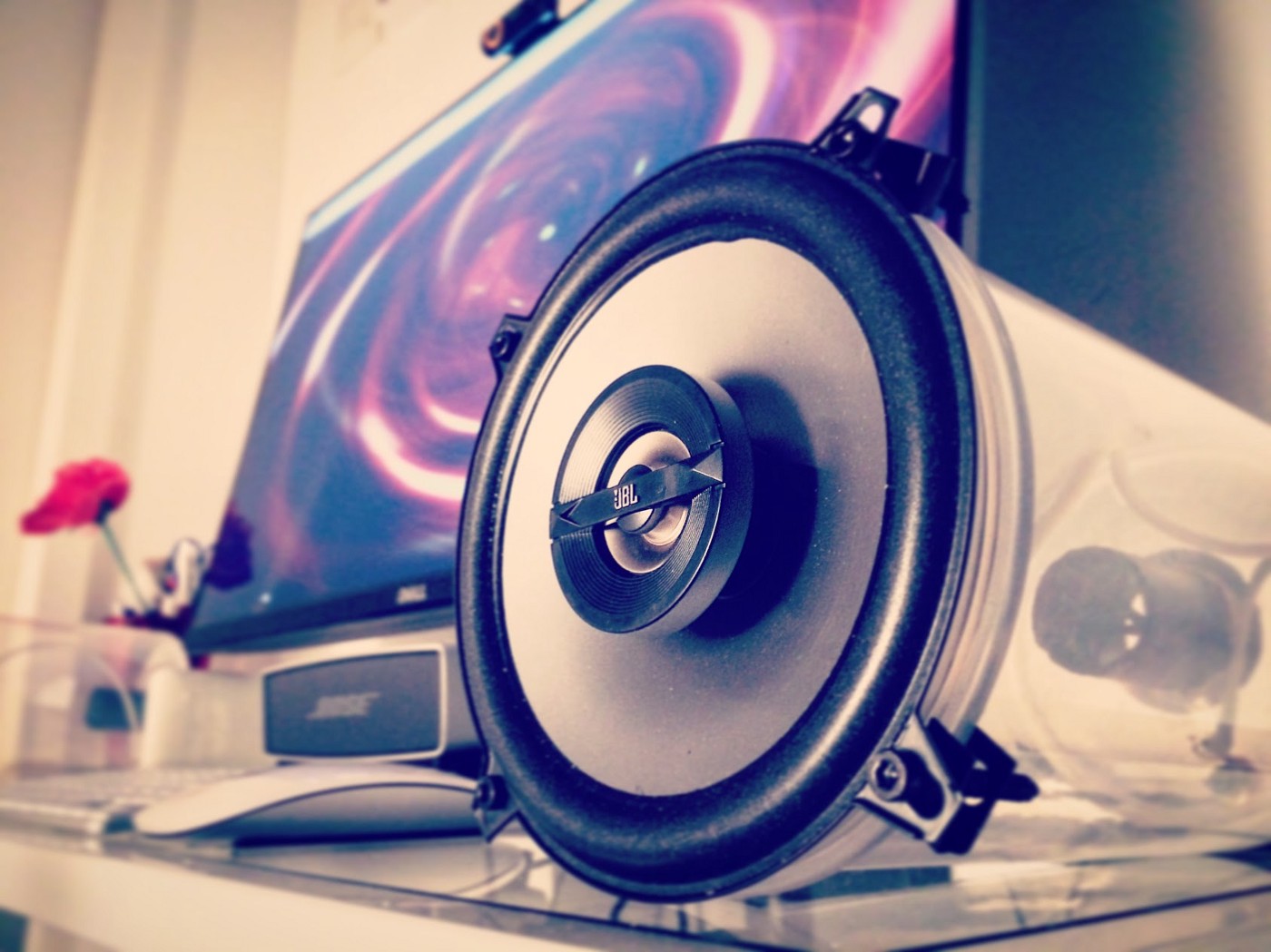
Although, it looks good, there was one problem with this setup — Car speakers are tuned to perform well inside a smaller sealed enclosure (your car). Therefore, the design of Thiele parameters for these speakers are way different than you would find on a normal household speaker. Besides, car speakers don’t use boxes. Unfortunately, I didn’t know these before building the box. As a result, the sound from my above setup sounded muddy, really below average, with the mid-range screaming into my ears.
I even tried changing it to a couple of enclosures, but with no noticeable improvement. So, I decided to do make some art with these speakers using some left over crates I had lying.
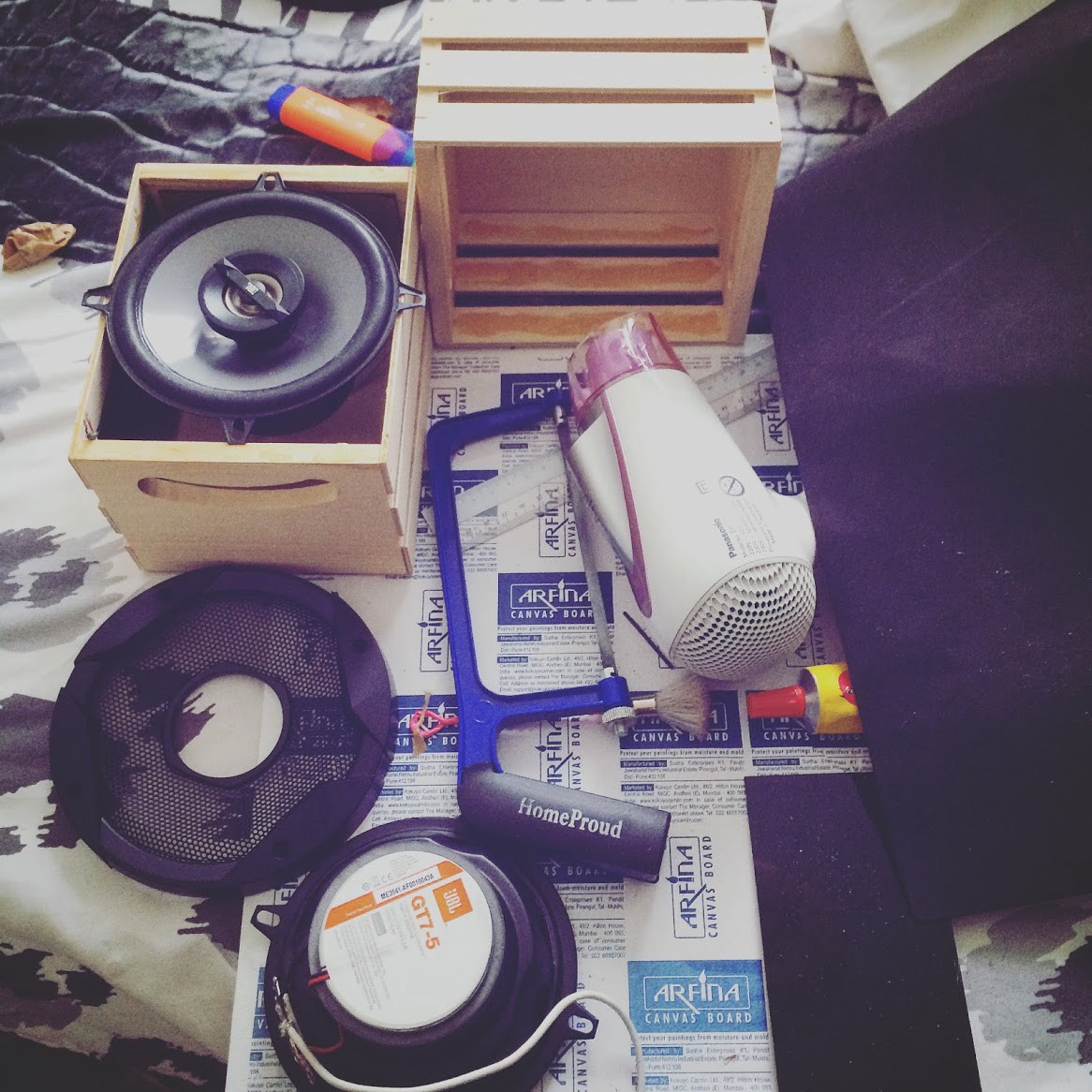
Here’s a video demonstration of the above setup:
Obviously, it wasn’t good enough. So, now I was $200 poorer and still, I didn’t have a good sound system.
Frustrated, and almost giving up on these DIY ideas, I decided to search for and buy a used Aiwa speaker from the second hand market. I bought this one for $5. Yes, you read that right — $5. It was advertised for just $10, but, since I had to travel a very long distance to get it, the owner was kind enough to give it to me for just $5. But, in reality, this costed me a lot more — a broken ankle and a bone fracture trying to carry these back to my home (they are quite heavy).
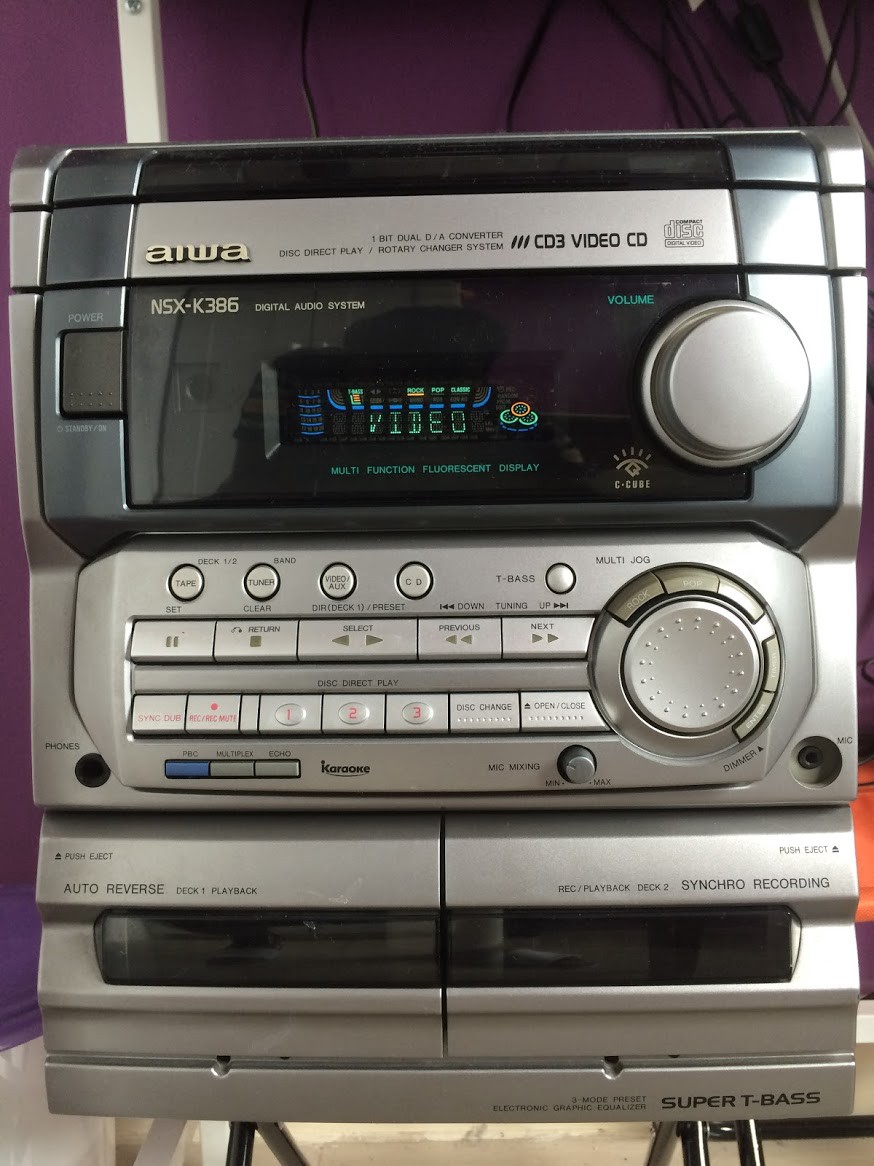
Except — It didn’t work at all initially, so I had to take it apart and fix it on my own.
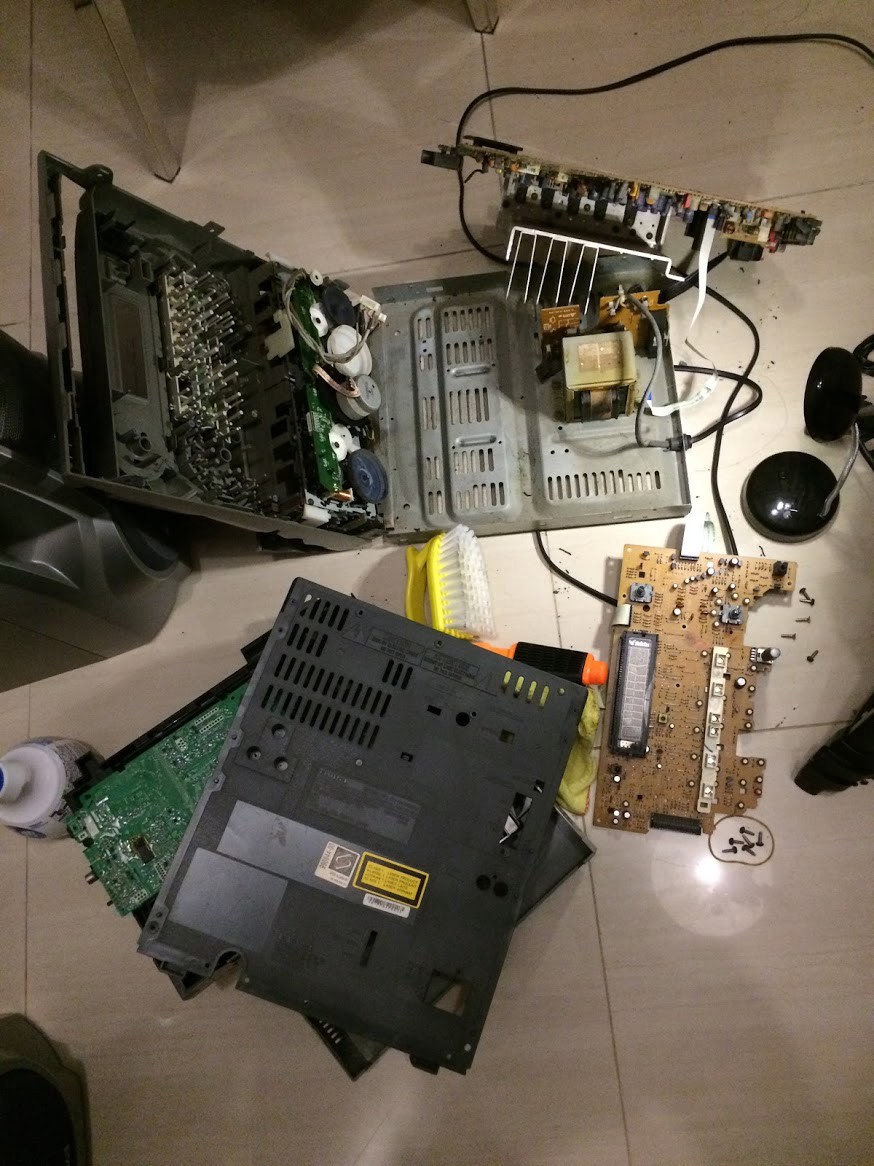
And finally, a weekend later:
A functioning and properly cleaned Aiwa system that was at the time of this incident, 30 years old! It wasn’t enough for me, and I ended up accumulating another Aiwa system that was over 40 years old.
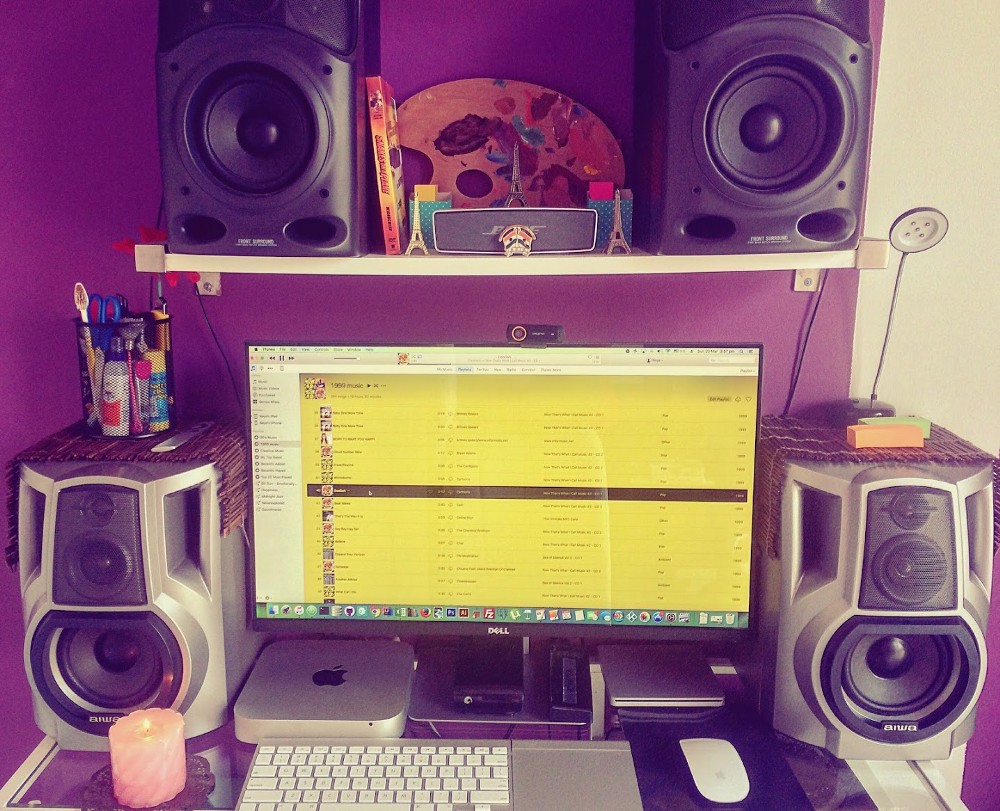
And finally, now, with everything connected, I was able to enjoy my favorite piece of music in peace. Phew!
The old Aiwa signature had re-kindled my fondest childhood memories and helped me re-discover myself from within.
And the sound signature was exactly as I listened to a decade and a half ago. I couldn’t be happier.
...
Truth hurts
After 6 months of enjoying the sound of these Aiwa speakers, I found myself wanting for more — I wanted to find out if this whole experiment was really true and worth it, or, was it all just a placebo effect?
Did Aiwa really have a sound signature? Or, am I just falling trap for the infamous audiophile world’s no-proof claims? And so, I set out to find an answer.
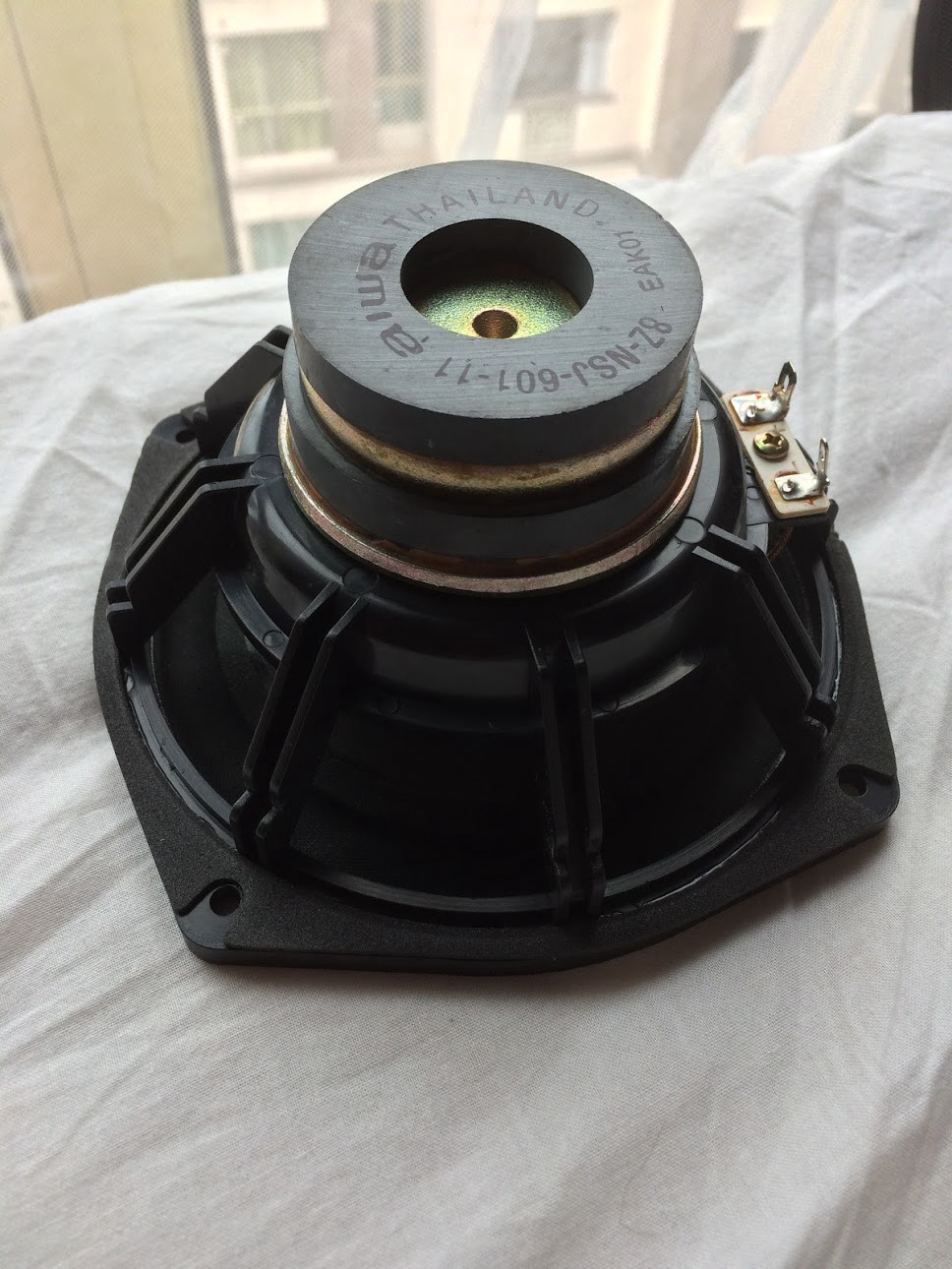
I started with the drivers, after all, only they can tell you about the sound signature. The two speaker boxes in the pink picture above were manufactured almost decades apart, yet, the main drivers still look almost the same. And I did further research and this was true of Aiwa’s other models as well. That shiny black dust cap in the middle was their (unofficially) trademarked design.
One look — and you’d know it was an Aiwa. Still, unconvinced, I broke open both speaker boxes to find out more.
And to my suspicion, both boxes used the same drivers, although my measurements did show that both the boxes were tuned slightly different — one was designed to resonate at 62Hz and the other at 71Hz. But, everything else about the sound signature remained.
But now, I had discovered something even bigger than what I was after — After opening one of the speakers boxes, I realized that Aiwa wasn’t how I imagined them to be — some sort of premium audio manufacturer. Actually, they were far from that — An average audio brand.
They used cheap plastics everywhere and the speaker box didn’t even have a proper crossover circuitry. At first, I was disappointed that my childhood hero wasn’t how I imagined them to be. And then, I started to read more into their story and found out how they died a slow, painful death and eventually got acquired by Sony around 2002..and it all made sense — the need to cut costs.
Despite this, what Aiwa really had and sustained was their sound signature — the unique emphasis of certain sound frequencies that makes you immediately identify that it’s coming from an Aiwa till their last breath.
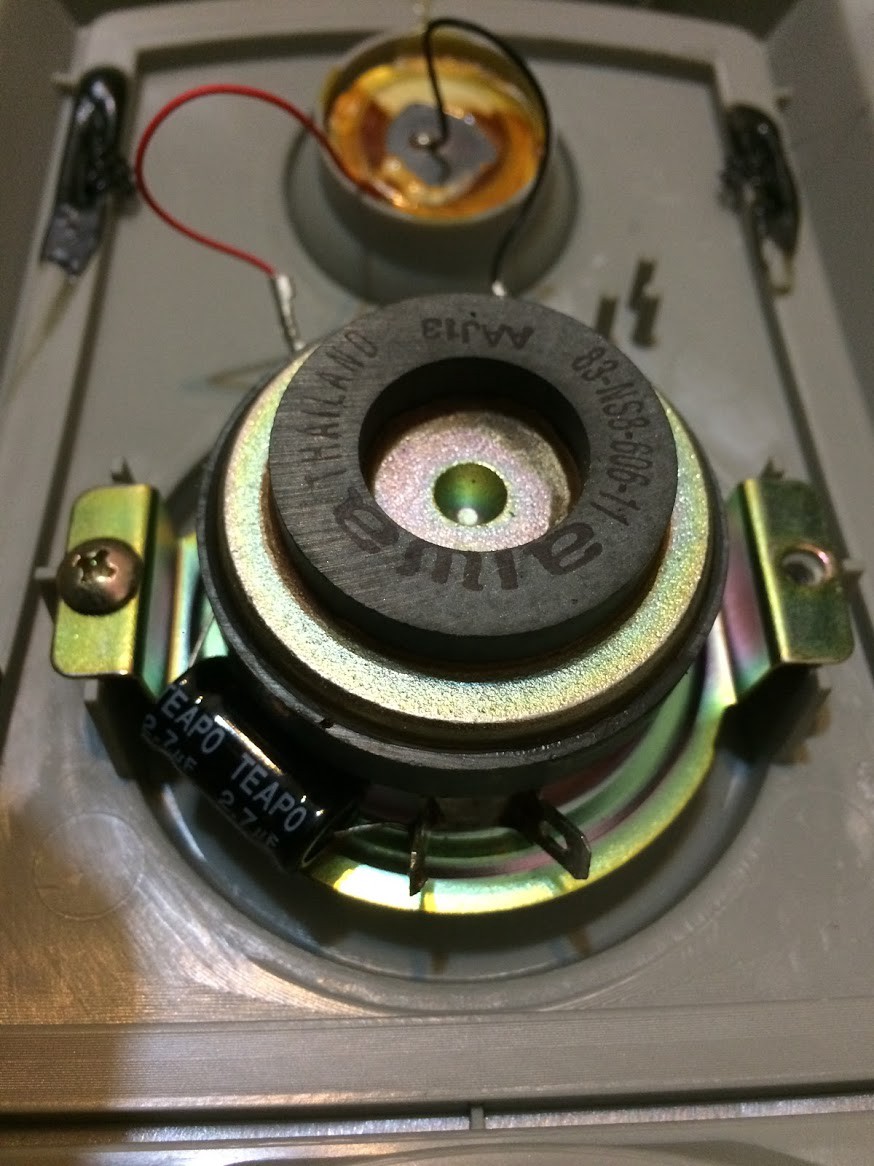
After thinking long and hard about this, I eventually concluded that the specifications of a loudspeaker don’t actually matter as much as its signature. If a 5" woofer can produce the sound you like, then, that’s all that you need. There’s no use inspecting if it’s of higher quality metal or lower quality metal as long as it produces the sound you like.
If I hadn’t opened the box, I would have been enjoying the music that I loved through the speakers I grew up with, blissfully unaware of the quality and specifications that were inside.
I started to research more on this subject and it turns out, I wasn’t the first one to discover this fact. In fact, Dr. Bose (founder of Bose corporation) had produced a paper that claims the exact same thing. In fact, it’s one of Bose’s official policy to not publish any sort of specification for their speaker systems, for exactly this reason.
Once again, I wanted to make sure I wasn’t thinking all these to convince myself and to save my (now) broken childhood memories. I broke open a Bose boombox lying around (Thanks to Vinoaj) and confirmed the same — Even Bose uses cheap quality paper speakers for a $500+ boombox. Or, Well, that’s one way of looking at it.
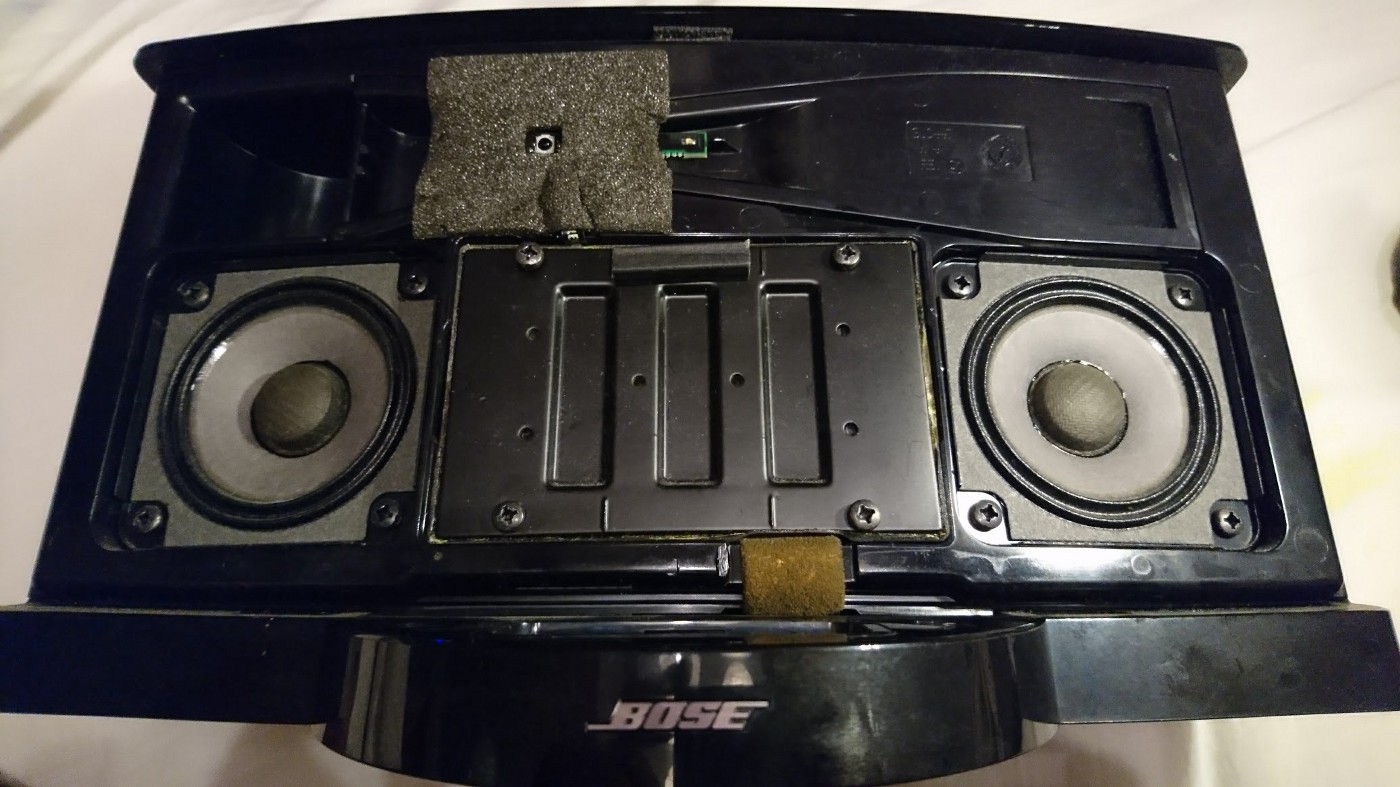
And so, with all these in mind, I decided I had enough of these mind games I was having with myself, and decided to really find something decent in the market for what I liked. But, everything out there was way too expensive and SO not my taste. These days, they only seem to make speakers for the party lovers and hence everything has heavy bass in it. That’s really, really not my type.
And so, it lead me to the most obvious conclusion —back to square one: D.I.Y.
...
Hello, Taiwan
Now that I had a pretty good idea of what kind of sound signature I wanted, I used it as a starting point to filter out the drivers. This is the most critical step as you simply can’t just look them up online and buy them if you are looking for a specific sound signature. You need to test them before hand.
Choosing the speaker size
One of the most important aspects of loudspeaker systems design is choosing the right size of the speaker. In fact, this decision will change everything about your project.
The most common speaker sizes in audio land are either 5" (or 5.25"), 6.5", 8" and 10" and 12". Of these sizes, 6.5" is fairly standard in consumer audio land. This is what most home component systems tend to usually use for their woofers. Even most DVD home theater systems tend to use 6.5" for their largest speaker — the sub-woofer.
There’s a saying in automotive sector that’s usually mis-quoted in audio land:
There is no replacement for displacement.
The translation is — bigger is always better, with reference to sizes of the internal combustion engines used inside cars.
However, in audio land, things seem a little different. In audio land, bigger doesn’t always mean better. The bigger your woofer gets, the more inertia, the more mass of the cone and the mover power needed to move it and control it. So, you need to find the sweet spot size that doesn’t make your woofer too big and at the same time, a size that doesn’t have all these drawbacks, while still providing good sound quality.
Perhaps, the biggest downside of choosing smaller speakers is the compromise in bass response. The smaller the speakers get, the lesser the surface area, thus the lesser the amount of air it can move and the lower frequencies in particular are the most affected.
So, with all these things in mind, I passed off 5" as I already had first hand experience with them and the bass response wasn’t satisfactory at all. 10" and 12" are really aren’t my cup of tea as they’re HUGE and I couldn’t afford the space they require for their setup.
8" is my ideal size, because they’re not too big, but not too small as well. But, that would also add too much to the cost of my project and because portability was one of my goals, it wouldn’t be suitable. But, I would have definitely chosen 8" if I wasn’t constrained by finance of portability requirements. Perhaps, for another project.
The last and the obvious choice was 6.5". In fact, the Aiwa themselves used 6.5" as standard on almost all their models. And besides, 6.5" has almost double the surface area of a 5" woofer. So, that’s good. Most importantly, the 6.5" had very good bass response as opposed to the 5". So, it ticked all the boxes for me and 6.5" was finalized.
Choosing the woofer type
Next, I started out by filtering out the types of drivers I was interested in and searched for vendors online. Contrary to popular belief, China makes most of the (best) speakers for almost all the popular brands out there. This includes, Sony, JBL, Panasonic, Samsung, etc. You name it and they’ve got a factory in China for sure. This is for a good reason as China has majority of the world’s natural magnetic ore. It just makes sense.
I started from the website Parts Express. I filtered out the drivers I was interested in, based on reviews there and the parameters published in the technical documents. How did I achieve this? Well, as an example for one of the parameters — I for one love speakers with long excursion. So, I searched for speakers with X-max > 4mm. That vastly filtered out my choices, so it was then a matter of fine tuning my selections after that.
I then shortlisted about 5 vendors I wanted to buy speakers from who sold speakers of these specs. I emailed each one of them and measured their response times and quality of service, since it was an important attribute to me to judge how well they stood behind what they sold.
Another reason was, I wanted to visit them directly and purchase the speakers on site. Why? Parts Express is an American website. The speakers are made in China. And I lived close to China, I would be wasting a lot of money on buying speakers from Parts Express and paying for their margins and shipping. And I have dealt with Chinese sellers before, most companies are professional and will honour their contracts, if you’ve signed one with them. You just need to make it clear beforehand about your expectations. That’s their culture.
And so, I made a trip to Taiwan to search these vendors out and buy a good pair of speakers for myself.
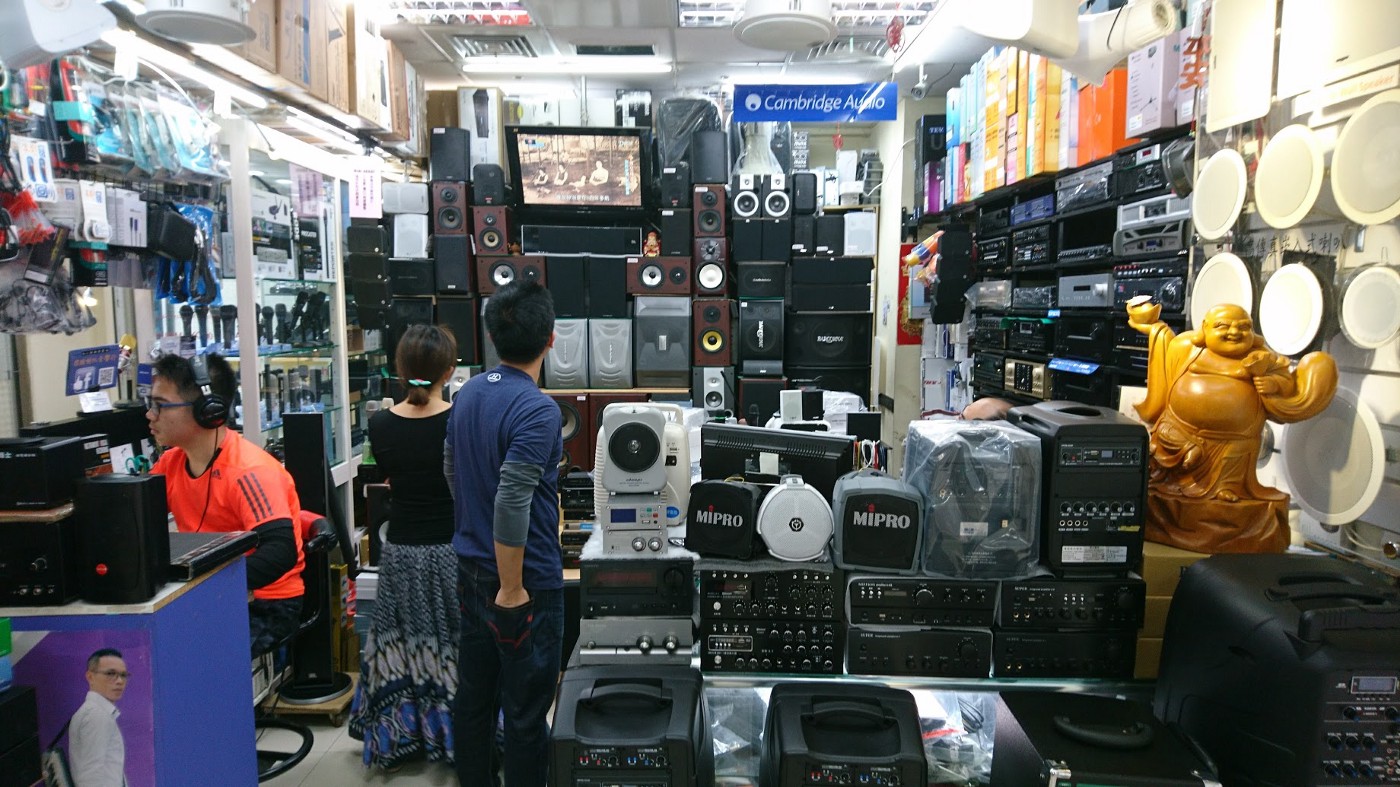
Taiwan is an interesting country. It’s unique in its own right while also being similar to China in many aspects. And despite its tensions with China, I’m not really a political person. So, I really am gonna leave it to the politics guys. All I know is both countries make excellent speakers, amplifiers and ICs.
Taiwan grew to fame because of its semiconductor industry. For example, HTC, Asus, are two Taiwanese companies which are two of the popular names in electronics at present. Many people think Taiwan products aren’t that great. The perception is wrong. In fact, Taiwan’s electronics are much better than many firms with good perception (such as Creative). Taiwan also manufactures a lot of white label products for many American conglomerates.
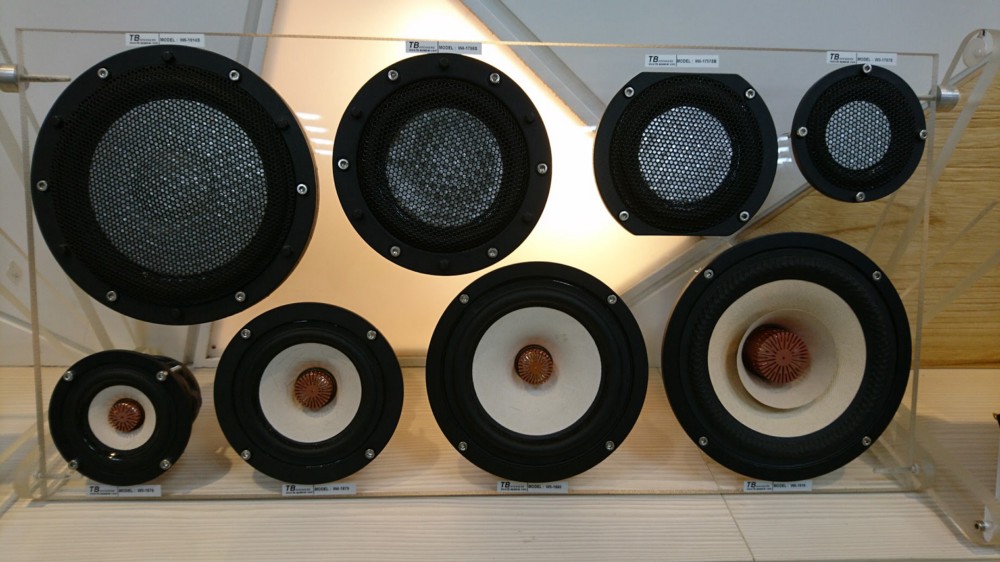
I started visiting each supplier one by one and boy, was I surprised at the warmth in welcoming me. Apparently, not many people have seen Indians before and so, I was treated with a lot of respect and hospitality.
However, I realized most speaker companies only had only sales offices in Taiwan and although they had demos of their speakers, which was my purpose, the main factory was really based in China.
Well, that wasn’t a bad news to me, since, this wasn’t the only I wanted to visit Taiwan anyway and I still got to listen to drivers I liked and shortlist them further. And so, I noted down the factory addresses of these companies in China and some were even generous enough to offer me free samples if I visited their factory in China!
And so, my trip to Taiwan had solved its purpose and all I had to do was do some sightseeing and I would be done. Here are some photos I snapped during my journey:
This is from a crowded food market in Taiwan.
Taiwan is really the place for food! They have a lot of night markets as well with different varieties of sea food and meat.
They also have a lot of different types of desserts that I’ve never tried before.
Taiwan isn’t usually crowded, it just so happens I decided to visit a popular market on a weekend. Most of the crowd you see here are tourists like myself just transferring to another food market nearby.
And so, my trip to Taiwan finally came to an end. All I had to do was now get to the factories in China.
...
Hello, China
A few months passed, and I got busy with my consulting work. I didn’t take any vacations as I slogged my life away for 80hrs a week. And so, it was about time I took a much needed break.
And you guessed it — China was it. For many reasons. First of all, China is not a popular destination for Indian tourists, so I really wanted to try it out. Most of the time, it’s due to the fear of incompatibility of food. But, since, I was already living in Singapore (which is predominantly Chinese culture), I had no problems with it.
Next, China has been portrayed by the international media as really a third world, an unsafe place to visit and so forth. And so, like many others, I had this mindset where I was bracing myself to face thugs, gangsters and petty snatch-and-run thieves.
But, visiting China totally changed my perspective and exposed how backward international media is and I myself was. Most people who criticise China haven’t visited China at all.
Why do I say this? Well, because China is far more advanced than any country I’ve visited till date. Don’t believe me? Just make a trip to Shanghai or Shenzen. Electric buses everywhere. The roads are pretty clean for a country like China. People are way more friendlier than any asian country you will get to visit. Almost everything seems well organized. Visiting China was one of the best travel decisions I’ve made personally.
Anyway, not to distract too much from my original pursuit, I started out with some vendors in Shanghai. I traveled all the way to Hangzhou, Nanjing and then up north to Beijing and back down south to a couple more factory visits. Since it was winter in some regions, it was terribly cold and I had to cut short my trip as I’m from a tropical region and the cold winter wasn’t really my taste.
I realized, most speaker factories in China were extremely competitive amongst themselves. Therefore, they fought hard even for a single order to beat their competitors. This lead to almost all of them having state of the art manufacturing facilities and really high quality manufacturing processes.
This is the reason why American companies establish an office in Shanghai or Beijing and contract the speaker manufacturing to one of these companies, then they assemble all of them into a well designed cabinet and slap their logos on top.
And this is the reason why I don’t like to buy branded items. If you’ve opened a speaker box from say, JBL you would find cheap steel-cast speakers with really bottom of the line material quality for the speaker diaphragms. The same goes for stuff from Apple and the others for other electronic components. Best example, ever wondered why that Apple charger cable frays too quick and doesn’t even last a year? :)
I for one hate paying the brand tax and I want most of my money to go to the components directly. So, I chose buying directly from the vendors in China. The other question I often get is why don’t I buy directly on AliExpress. Here’s the problem — AliExpress is a B2C site. Therefore, the margins there are easily as high as 40% or even more. And there’s another problem with AliExpress — Dropshippers. These are nothing but intermediates who simply buy the speaker from a vendor, re-badge it and resell it at 50% mark up. They don’t have a real presence most of the time, perhaps just a tiny office for namesake and they don’t have their own factory either. So, it’s common to find the same product under different badges on AliExpress and elsewhere.
Buying directly from the factory avoids all this, plus you get to maintain a good relationship with the company, should you need more in the future.
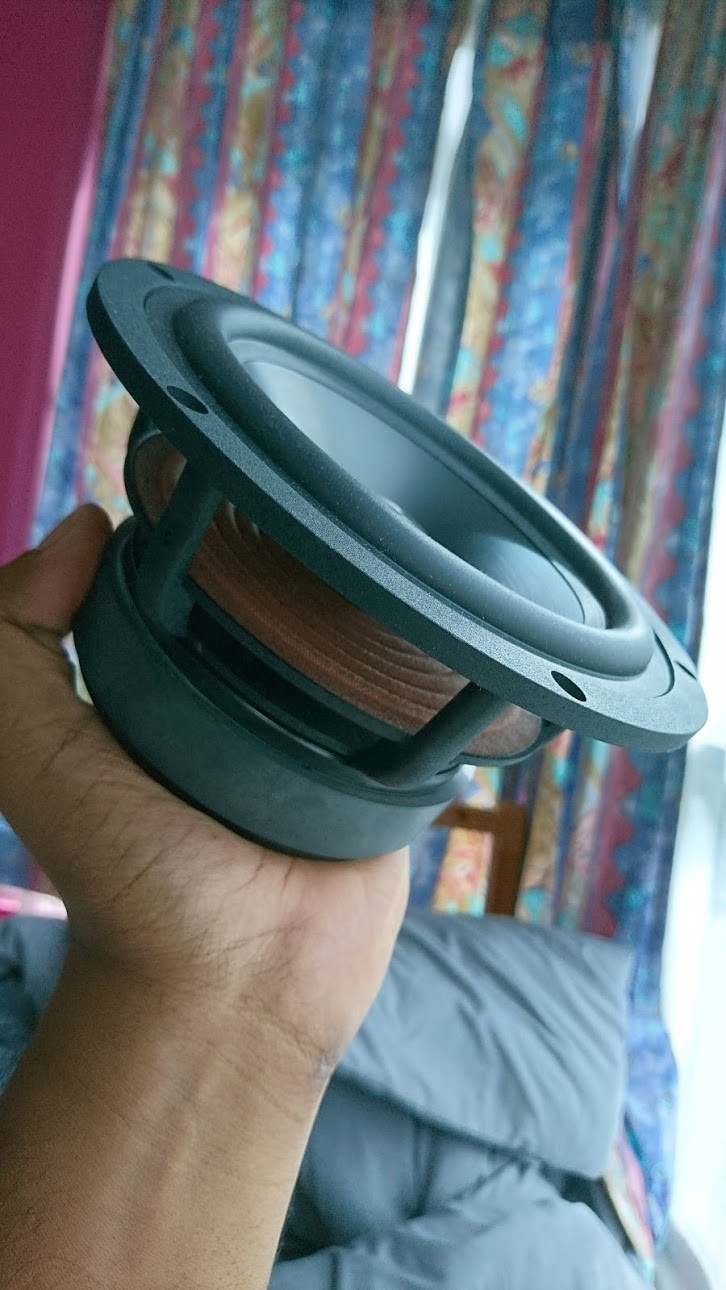
And hence, just a day before my trip ended, I met a supplier (a factory) bought the speakers of my choice directly and all is well :)
(One problem in China is most of them are pretty aware of their privacy and also due to the language barrier, it’s hard to convince them for snapping photos, especially inside their factories.)
I chose a really well built, Aluminium frame woofer with Aluminium diaphragm. The reported resonant frequency was around 62Hz and my testing proved the same. It had really nice X-max as well, which really seemed like the perfect speaker for me. I don’t remember the supplier name, since it was in Chinese and I was rushing to avoid missing my flight.
Finally, after the tireless supplier search, I was now back in Singapore, with the speakers of my choice. Now, all that was left to do was to design the enclosure, run some tests and set up my sound signature.
...
Hello, India
Since we are now running this project under budget constraints, I figured it made financial sense to get this done in India as everything here is really, really cheap and cost effective. And also, I happened to visit India at the time and thought it would be a good opportunity to go full on with my speaker project.
Designing the box
For my box design, I used BassBox Pro, which is the industry standard software for designing enclosures. It’s pretty straightforward as well, except for the fact that it ran only on Windows. Sadly, there’s nothing out there for Macs.
I used VirtualBox to run the software and all I had to do was feed it my speakers’ parameters and requirements for my box and it took care of the rest.
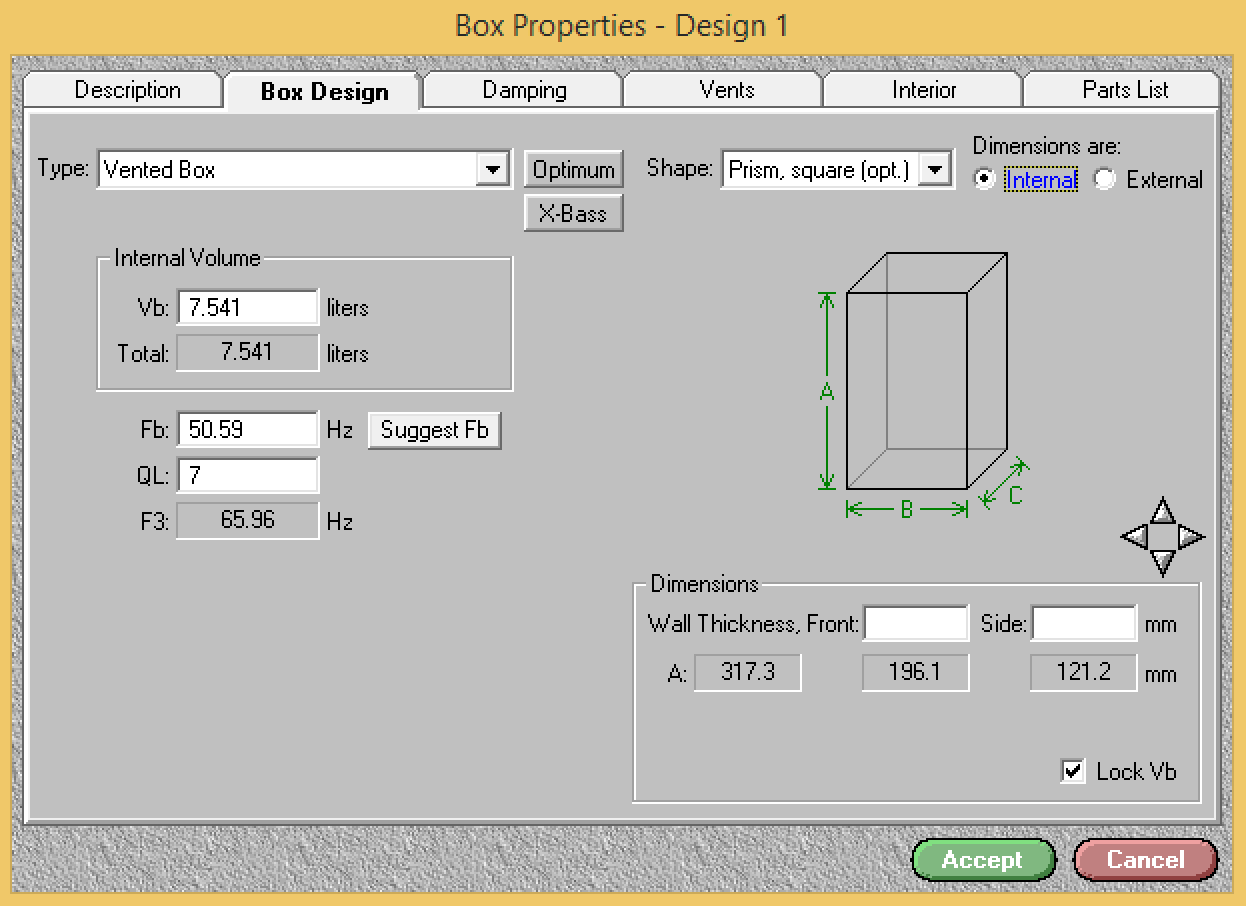
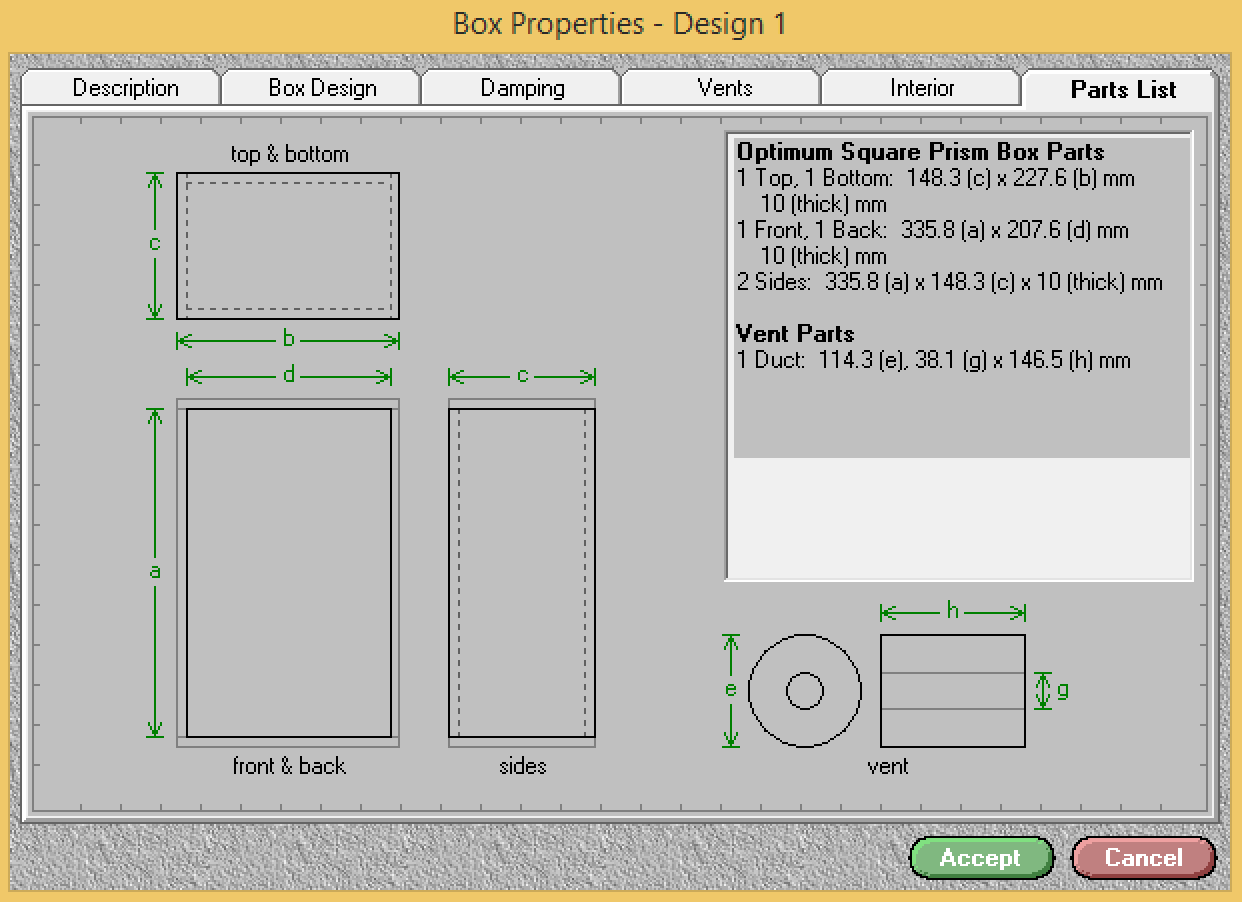
Now that I had the required dimensions for the box, the next step was to go for some shopping for wood.
Selecting the right wood
MDF is the wood of choice for speaker enclosures since it has very good compression properties as opposed to other types of wood, although, some like to build them with plywood and few even with walnut wood as well.
I was on a tight budget after blowing out money on my trips and settled down on MDF since it’s considered as the standard material for enclosures.
I drove about 600+ kms all the way to Tirunelveli, to meet my favourite carpenter, who has been making boxes for over 30 years now and who is the only one I trust this project with as I have worked with him in the past.

Upon reaching there, we wasted no time and immediately got down to business.
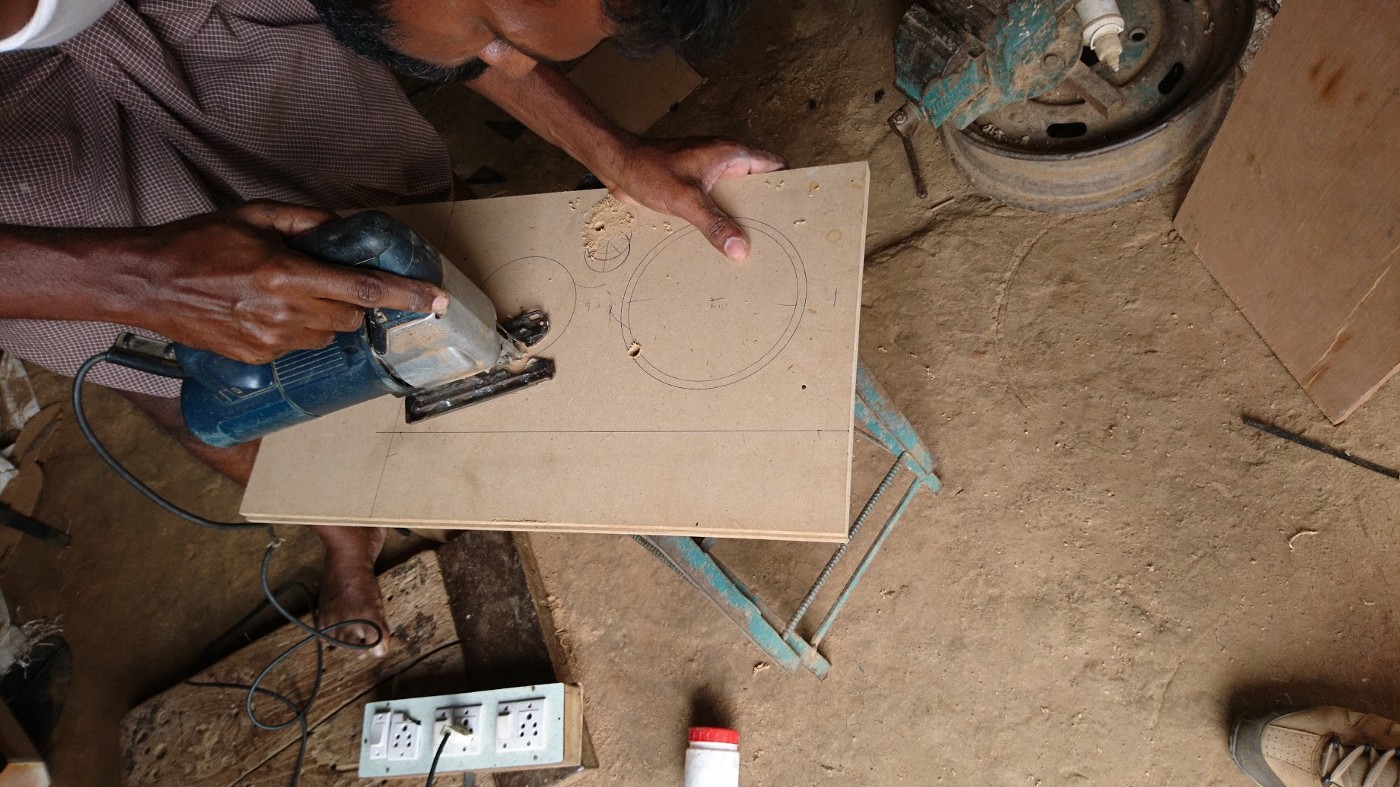
I shared with him my required dimensions and he started off cutting the MDF board for me.
He is fully capable of building the whole box himself, but where’s the fun in that? And so, I just got the cut out boards from him to do carpentry myself, later.
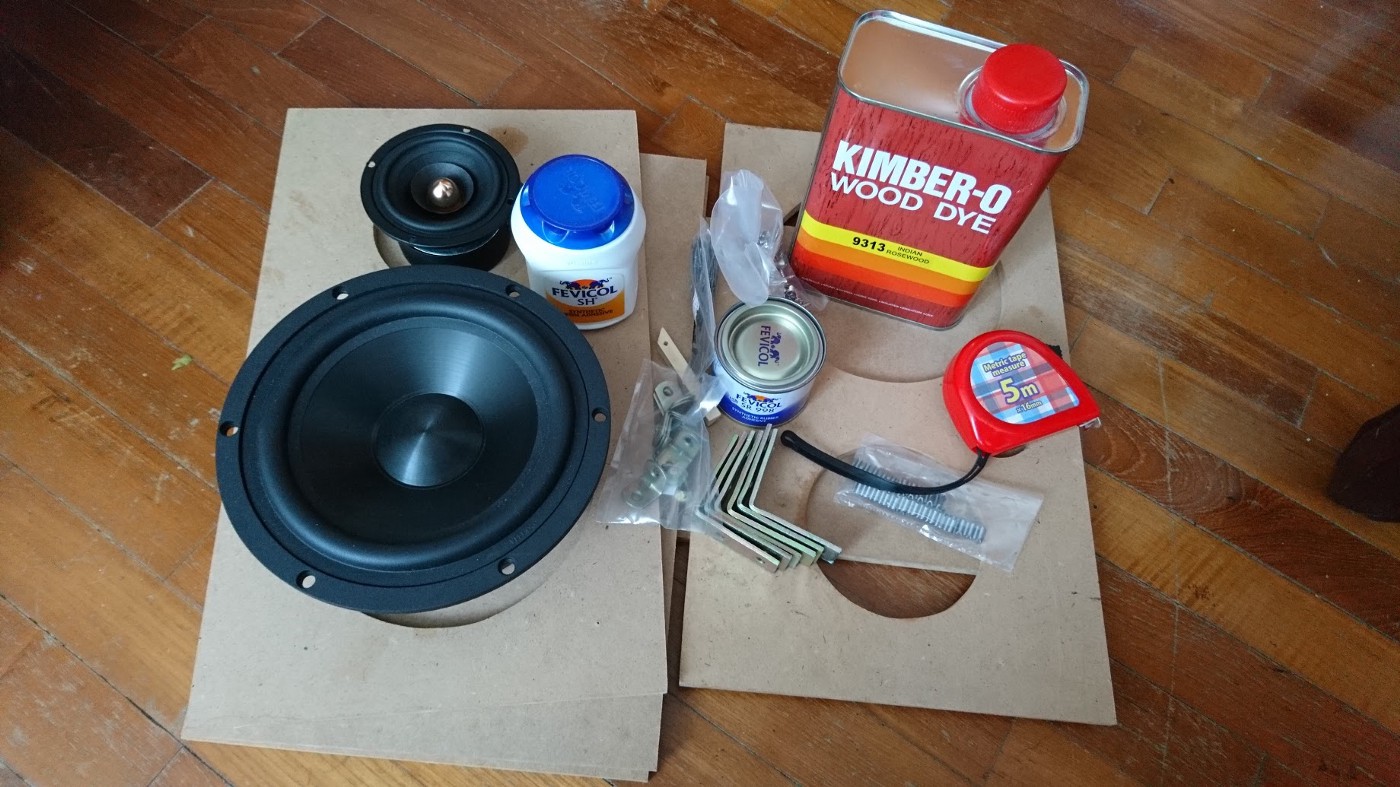
Everything was ready. The design I had in mind was a transparent speaker box surrounded by glass panels on both sides. So, after some carpentry work, it turned out quite well.
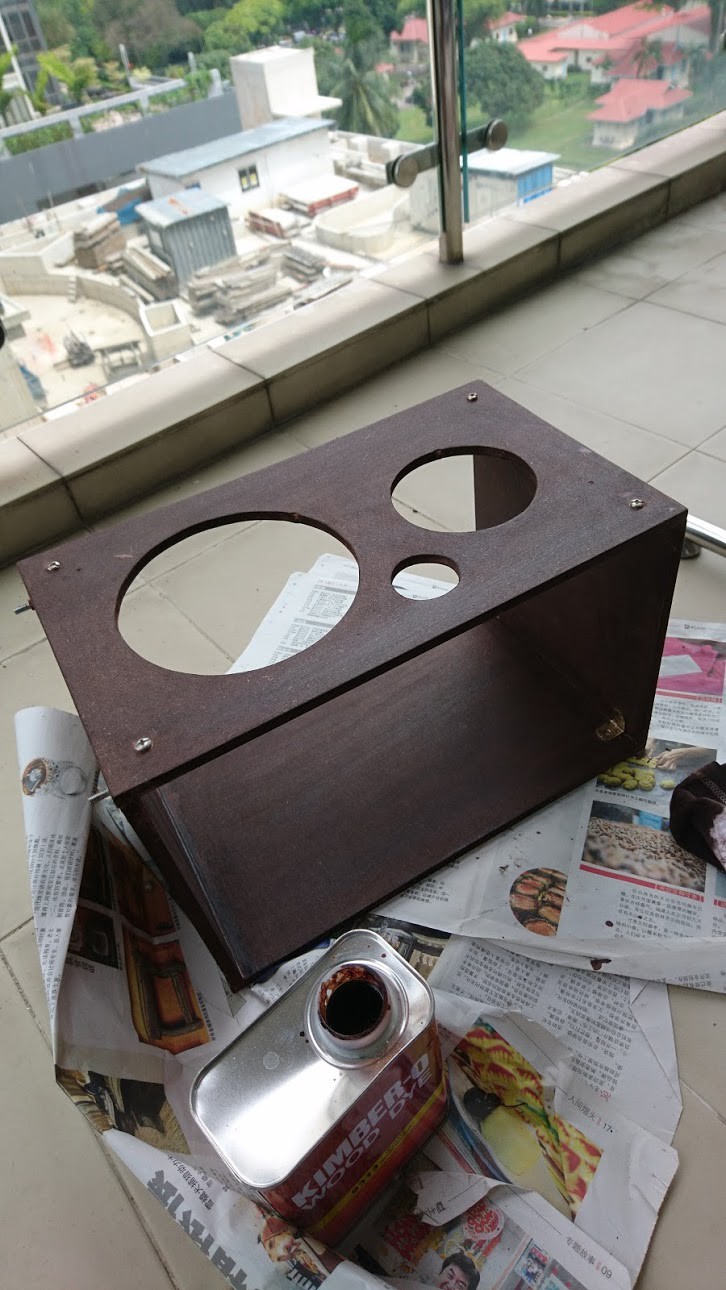
However, there is a problem that’s not immediately obvious. The wood I chose is quite thin. Testing revealed that the woofer would easily destroy the joints in no time. That was not just it, the box would also now vibrate along with the speakers and lead to unintended sound frequencies crippling my sound signature— thus defeating the purpose of this project.
You see the problem with being a software engineer and not a real carpenter? Experience. In fact, my carpenter did warn me of this, but I shrugged it off like it would be no problem.
Sadly, I had to dump away this beautifully finished piece, since it can’t really be re-used anymore.
And so, we’re back to square one again. Fortunately, I had the chance to travel back to the same carpenter again and get the box re-done from him directly.
So, here we go again — round 2:
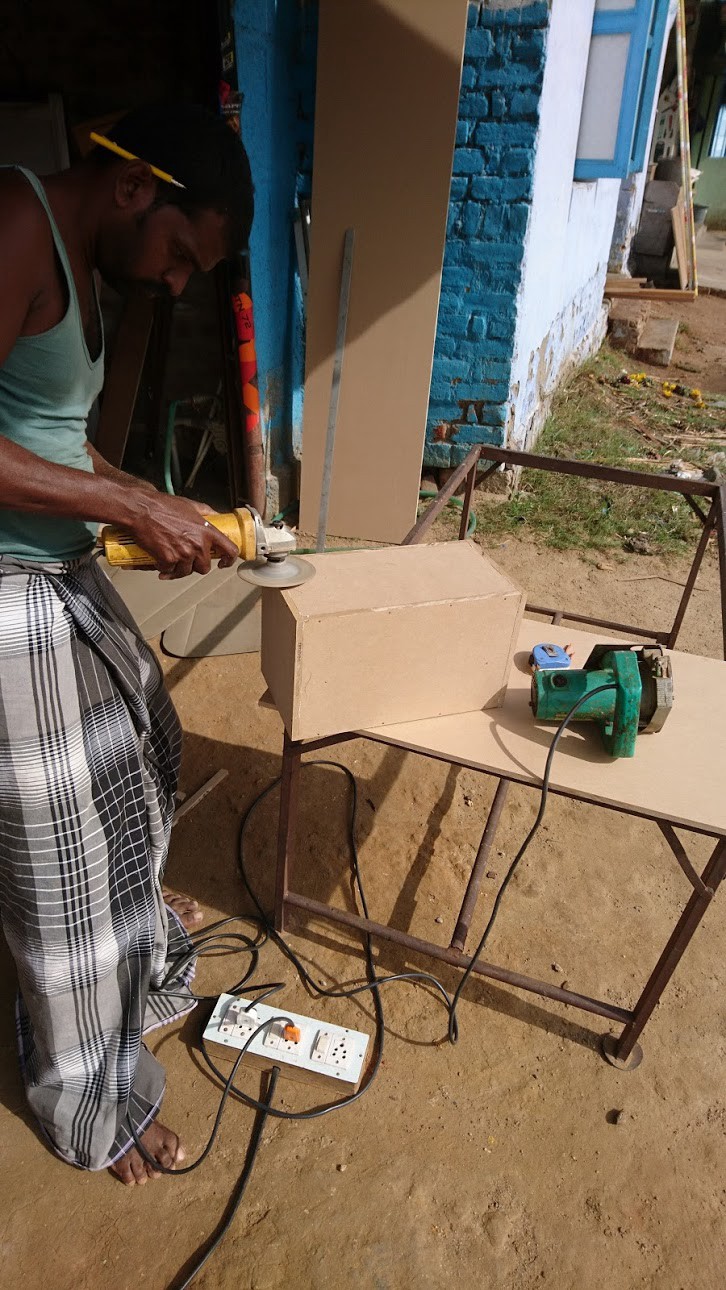
Finally, the box was ready and all I had to do was test it for flaws and tune the sound signature to my liking.
The right sound
How does one find the “sweet spot” in sound? It’s simple. I call it the drum test. If a given loudspeaker box can faithfully produce the sounds from a drummer, then it’s the right sound. Why the drums? Why not the Piano or Guitar?
Most instruments contain only one type of note that is either played high or low at a given time…unless they’re played as chords. But, in a drum, it’s normal to play very low frequencies (kicks) and high frequencies (cymbals, hats) at the same time to produce music. That’s why. A good box can produce these ultra low and high frequencies at the same time with ease. So, there you go, that’s your right sound!
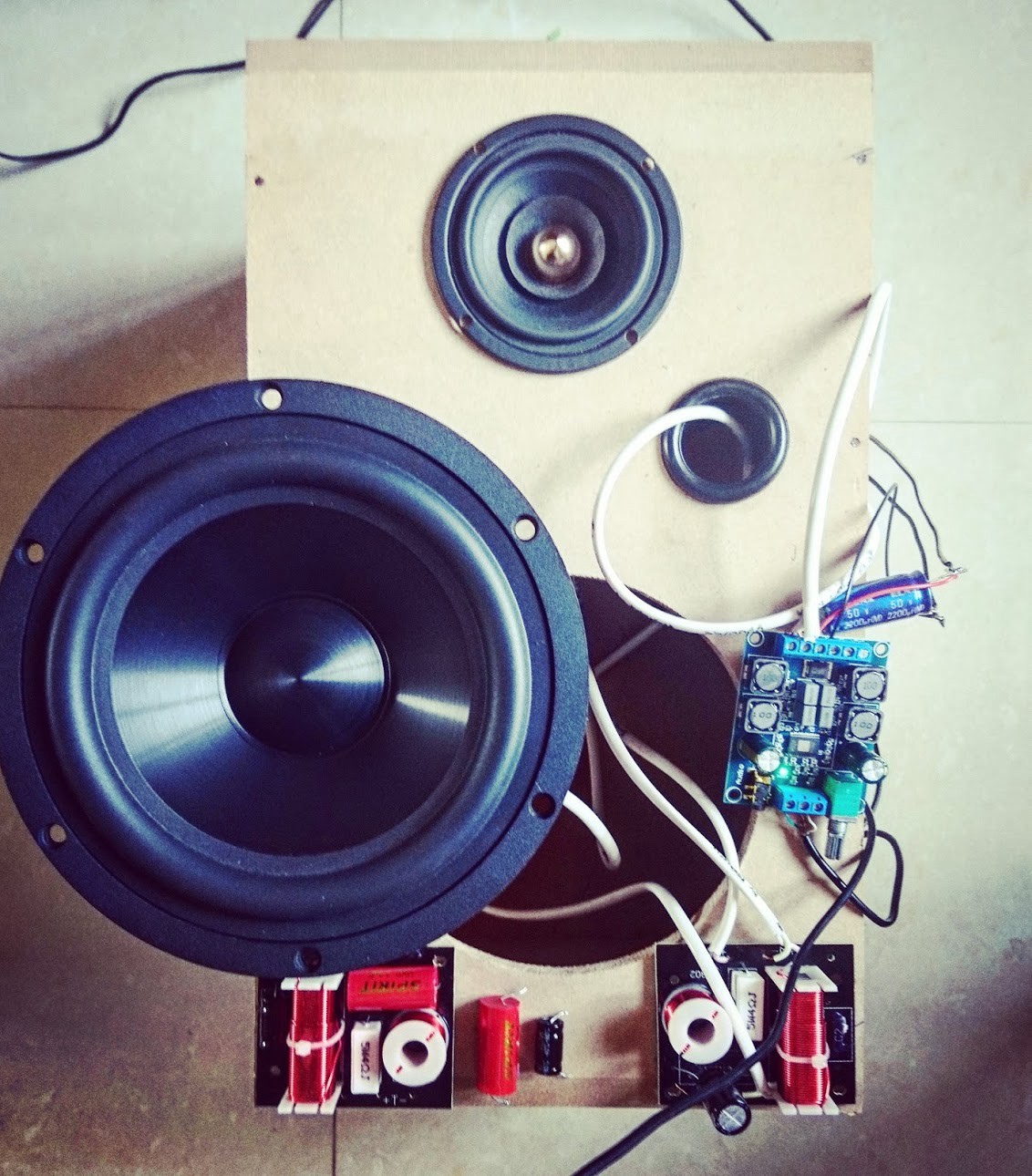
Now, that I was satisfied with the box’s performance, all that remained was to paint it.
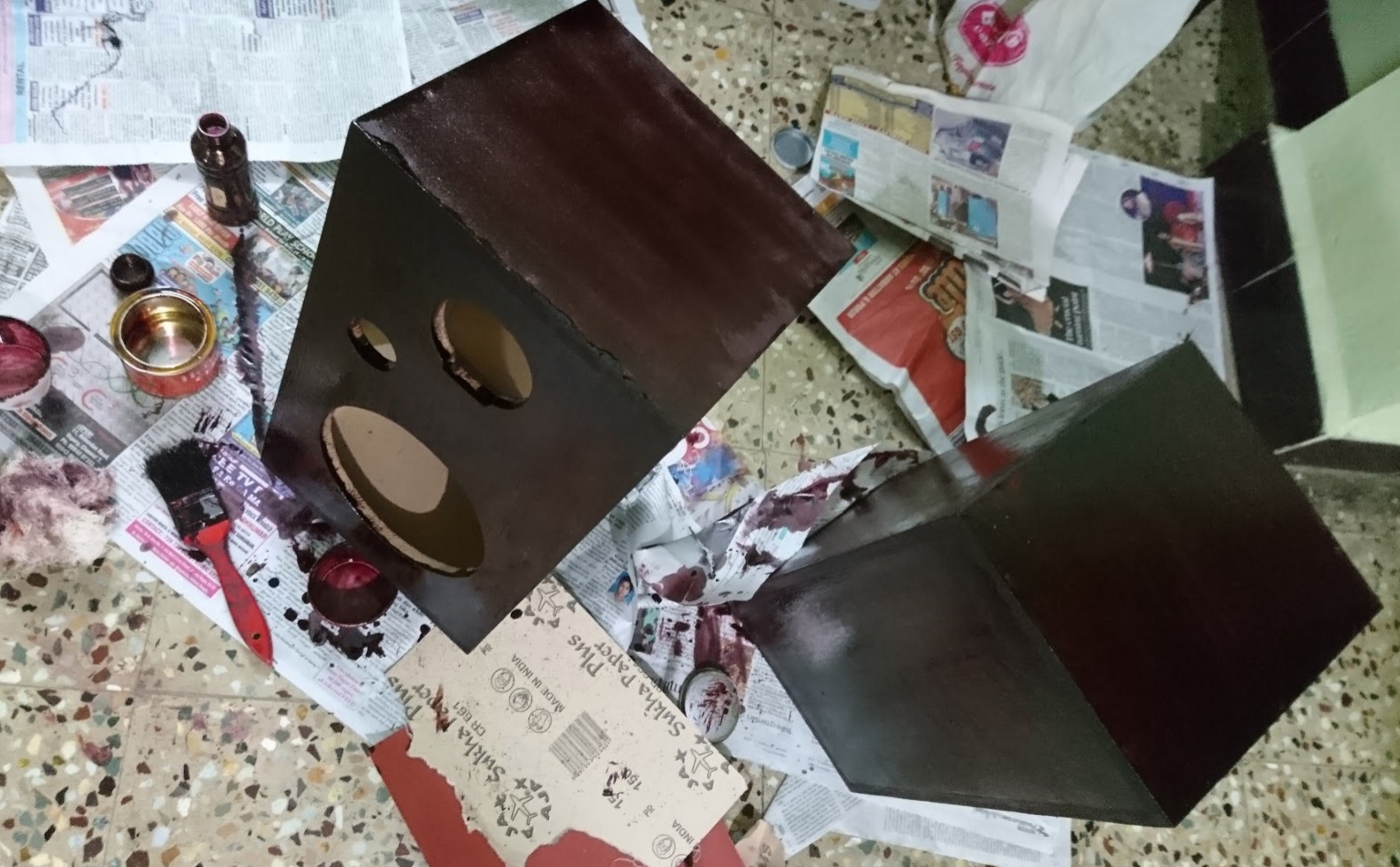
Unfortunately, for a software engineer, painting isn’t the easiest of jobs. I tried different variants, colors, mixtures and what not. I had to scrape off the paint several times with sand paper and re-coat it till I was satisfied with the results. It took me almost two weeks to settle down with satisfaction.
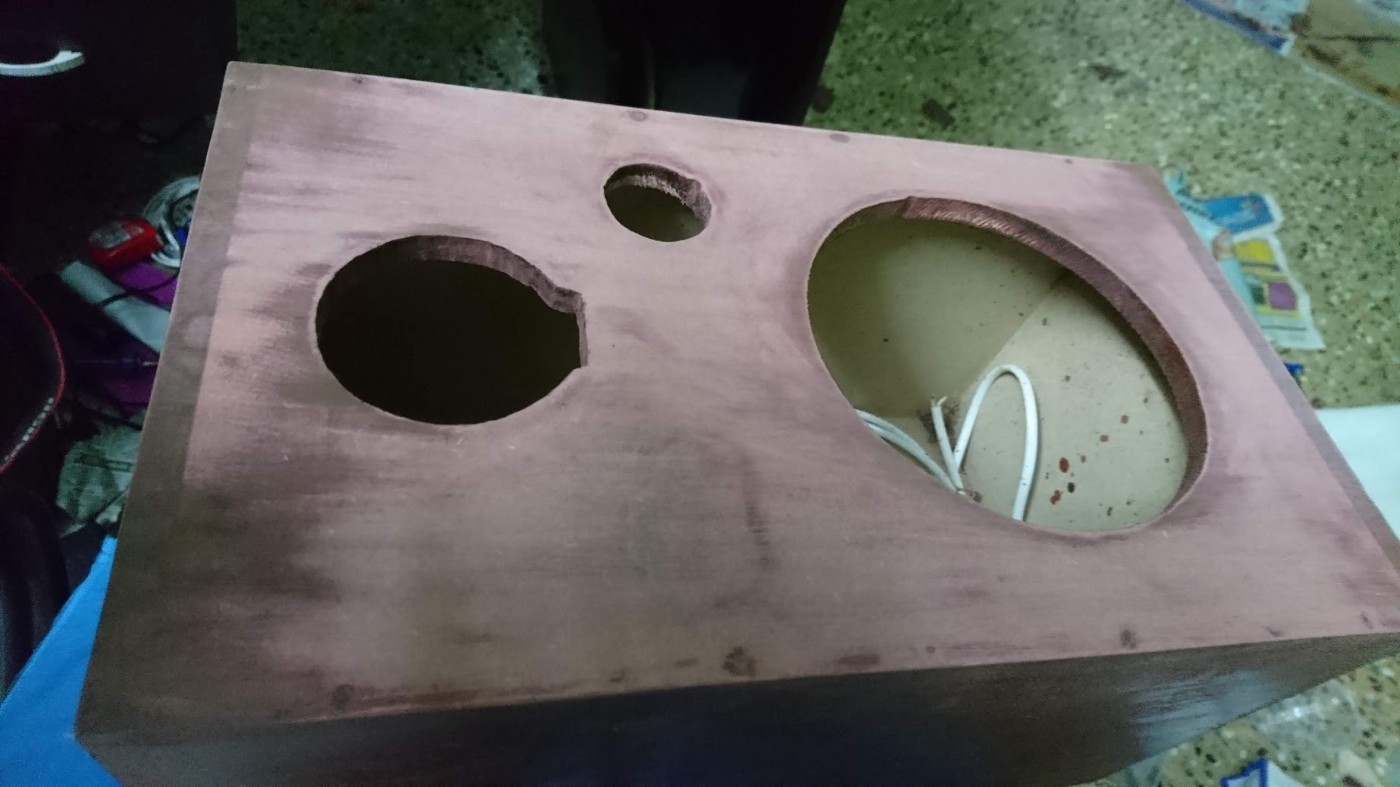
The secret is to mix the right amount of paint and varnish together and use a good brush for your first coat of paint.
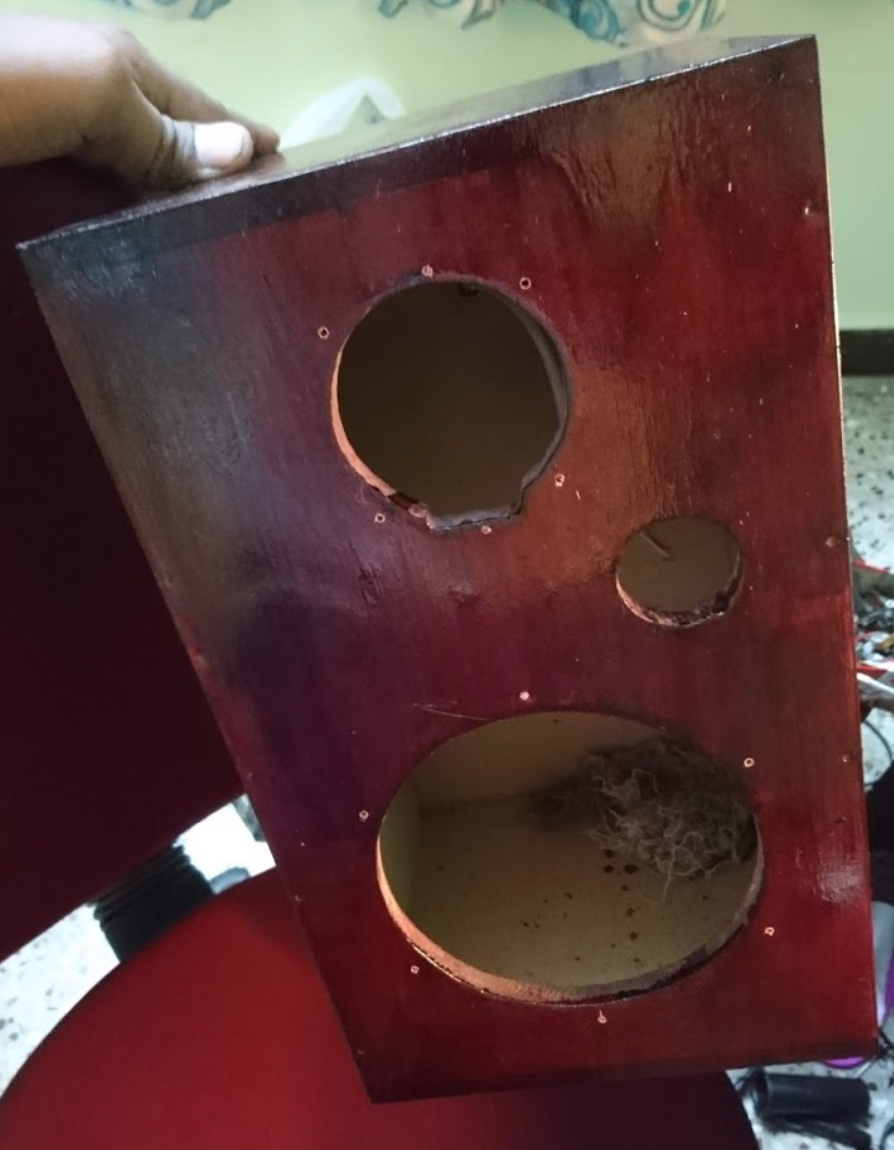
Now that the paint has dried, the finish starts to look much better. There’s still some uneven edges I would need to sand, but atleast, now I know my mixture of varnish and paint was perfect.
The other important takeaway here is don’t let it dry in the sun. It really ruins the finish and also, there’s a lot of dust outdoors.
You want to let it dry in the interiors so that dust doesn’t settle over it and ruin your hard work. You also want to ensure there’s proper ventilation since the smell from the paint and varnish would be really strong.
I recommend letting it dry in the wash area, or inside a closed store room, if you have one.
And after everything is all said and done, et voilà:
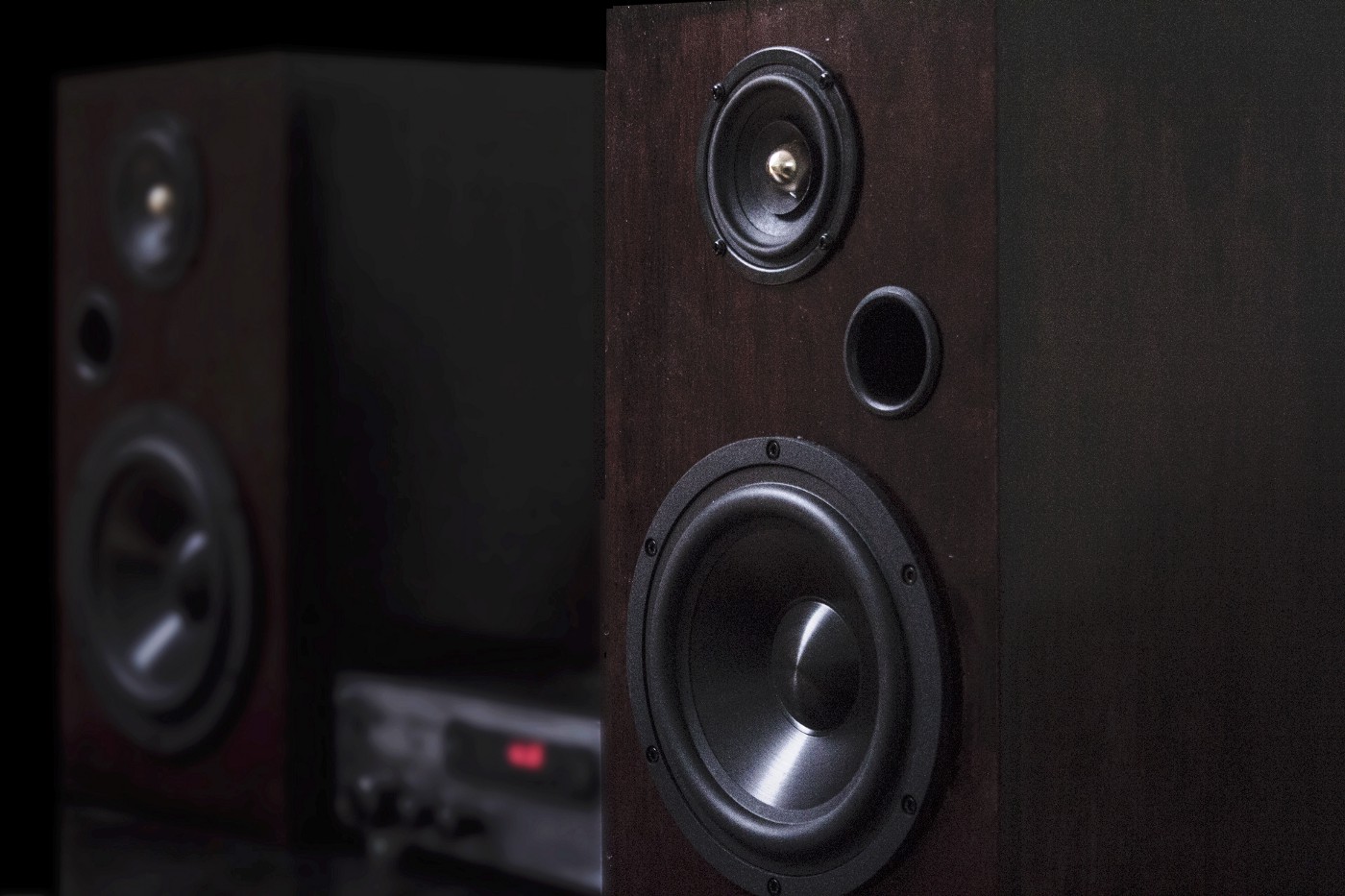
Building the amplifier
In my next post, I’ll continue this story on part 2 of this article.
Thanks for reading. If you’ve liked what you’ve read so far, kindly consider following, subscribing.
